Canada’s first State of youth report: for youth, with youth, by youth
This publication is available upon request in alternative formats.
On this page
- List of figures
- List of acronyms and abbreviations
- Foreword message from the Prime Minister
- Foreword message from the Minister of Diversity and Inclusion and Youth
- Foreword message from the State of Youth Report Youth Advisory Group
- Introduction
- The state of youth 2021 – in their own words
- Conclusion
- Annex A: Glossary of terms
- Annex B: Spotlight on engagement data
- Annex C: Youth Advisory Group and young artist biographies
Alternate format

Canada’s first state of youth report: for youth, with youth, by youth [PDF version - 33.5 MB]
List of figures
- Figure 1. SOYR Youth Engagement Infographic
- Figure 2. Can you make a meaningful difference in helping achieve reconciliation.
- Figure 3. Whose Responsibility is Truth and Reconciliation?
- Figure 4. Percent of Youth Volunteering in Environmental Organizations
- Figure 5. Environment and Climate Action Overall Themes
- Figure 6. Health Status, Access to Healthcare and Life Satisfaction
- Figure 7. Health and Wellness Overall Theme
- Figure 8. Mental Health Theme
- Figure 9. Political Activity of Canadian Youth
- Figure 10. Youth Feelings of Confidence in Public Institutions
- Figure 11. Leadership and Impact Overall Themes
- Figure 12. Government Theme
- Figure 13. Rate of Youth Overqualified for Jobs
- Figure 14. Rate of Employment, Unemployment and Employment of Youth with Disability
- Figure 15. Employment Overall Theme
- Figure 16. Barriers to Employment
- Figure 17. Levels of Educational Attainment
- Figure 18. Equity Theme
List of acronyms and abbreviations
- 2S
- Two-spirit
- BC
- British Columbia
- CTA
- Call to Action
- K-12
- Kindergarten to Grade 12
- LGBTQ2
- Lesbian, gay, bisexual, transgender, queer, two-spirited
- Portable Document Format
- PhD
- Doctor of Philosophy
- PMYC
- Prime Minister’s Youth Council
- POC
- Persons/people of colour
- SOYR
- State of Youth Report
- STIP
- Science and Technology Internship Program
- SWPP
- Student Work Placement Program
- TRC
- Truth and Reconciliation Commission
- TRU
- Thompson Rivers University
- YAG
- Youth Advisory Group
- YESS
- Youth Employment and Skills Strategy
Foreword message from the Prime Minister
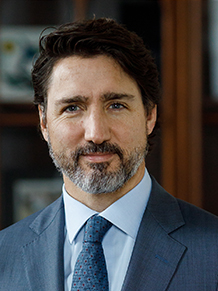
I am happy to welcome the first-ever State of Youth Report. Informed by nearly 1,000 young people of diverse backgrounds from across the country, this report recognizes the contributions of youth in Canada, and their potential to shape a better future for everyone.
Youth in Canada are engaged, resourceful, and resilient. They are the leaders of tomorrow, and of today. They understand the biggest issues facing our country, and they have the ideas and solutions to address them. The report focuses on their largest priorities, including truth finding and reconciliation with Indigenous Peoples, the environment and climate action, health and wellness, leadership and impact, employment, and innovation, skills, and learning. It outlines their important viewpoints on these issues, and introduces their vision for building a better Canada that works for everyone.
The past year has been challenging for everyone as we battled a global pandemic, and youth in Canada have been among those most impacted. They have made immense sacrifices to protect their parents and grandparents, and we must put them at the centre of our recovery as we build back better from this crisis. That is why the Government of Canada has made investments to support vulnerable youth, including those facing barriers to employment, as well as to make it easier for young people to pursue and complete their education, pay down student debt, and find training and work opportunities. Youth in Canada hold our future in their hands, so when we invest in them, we are investing in Canada’s success and long-term prosperity.
I thank the hundreds of young people who contributed to the creation of this report, and all others involved in its preparation. As the previous Minister of Youth, I look forward to advancing this crucial work, both through my Youth Council and the continued implementation of Canada’s first-ever youth policy. The government will continue to listen to the voices of youth in Canada, collaborate with them, and take action to empower them to drive change in their communities and make their dreams a reality.
The Right Honourable Justin Trudeau, P.C., M.P. (he/him/il)
Prime Minister of Canada
Foreword message from the Minister of Diversity and Inclusion and Youth

Canada’s first-ever State of Youth Report is unique in so many ways, and is a reminder that youth across the country are bursting with new and innovative ways of addressing some of our country’s most complex issues.
The recommendations contained in this report are a result of engagement sessions with approximately 1,000 young people, including First Nations, Métis, Inuit, Black and racialized, and LGBTQ2 youth, many of whom are facing barriers to meaningful participation in society. Through my work as Minister of Diversity and Inclusion and Youth, I’ve had the opportunity to meet with many of these youth and I’ve seen how committed they are to building a better country.
Their commitment is not only inspiring, but also a call-to-action in the areas of Leadership and Impact; Health and Wellness; Innovation, Skills and Learning; Employment; Truth and Reconciliation; and Environment and Climate Action. Through the lens of these six topics, this report highlights the opportunities and challenges faced by youth in Canada based on their lived experiences.
They further identify significant issues around environmental justice, access to education and mental health supports, job security, and the ongoing need to have a culturally-sensitive approach to the truth and reconciliation process with Indigenous communities.
Like Prime Minister Justin Trudeau, I believe in the power of youth - which is why it was so important to ensure that this report was developed “for youth, with youth, and by youth”. While it might be the first report of its kind, we know that it is a continuation of our government’s longstanding commitment to build a better future for youth in Canada.
I would like to thank the members of the Youth Advisory Group (YAG), the young artists who contributed their stunning art work, and all the partners convened by the Federal Youth Secretariat, including all the young people who took part in the productive engagement sessions.
The State of Youth Report (SOYR) responds to a commitment in Canada’s Youth Policy, and ensures that the voices of young people are heard, recognized, and reflected in an authentic way in all of our decision making, while also describing some of the programs that are currently offered.
We must also remember that youth in Canada represent a diverse cross-section of society as individuals with unique circumstances based in part on where they live, their stage in life, and their background. These intersectional identities contribute to the rich diversity of our country, but sometimes also hinder youth from reaching their full potential.
With this important context in mind, I invite you to read this report, reflect on the recommendations, and learn more about the state of young people in this country – including the impact of the COVID-19 pandemic on their lives.
I truly believe that listening and hearing from our young leaders is the only way we will build a better future for all Canadians.
The Honourable Bardish Chagger (she/her/elle)
Minister of Diversity and Inclusion and Youth
Foreword message from the State of Youth Report Youth Advisory Group


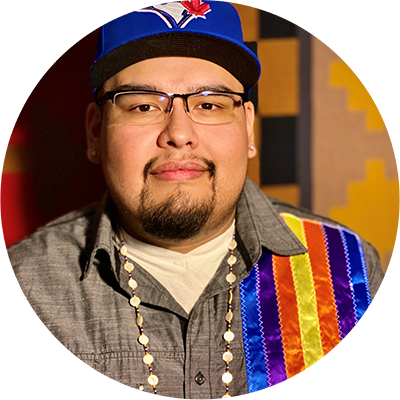
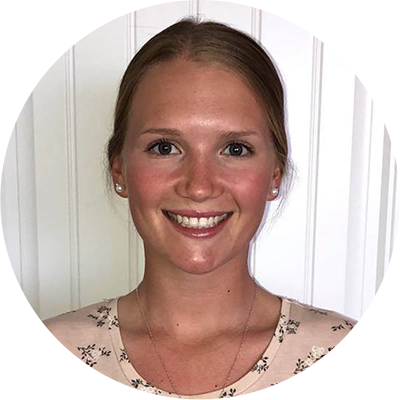

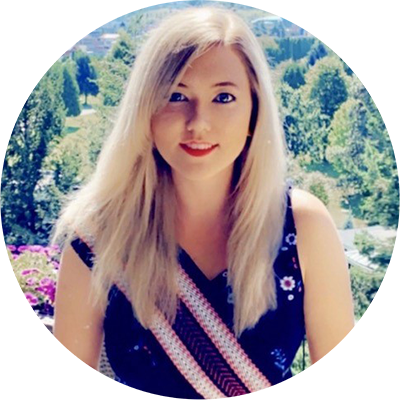


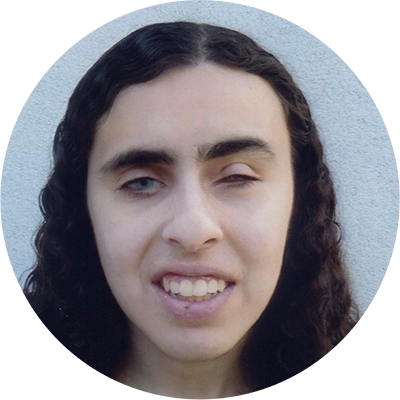



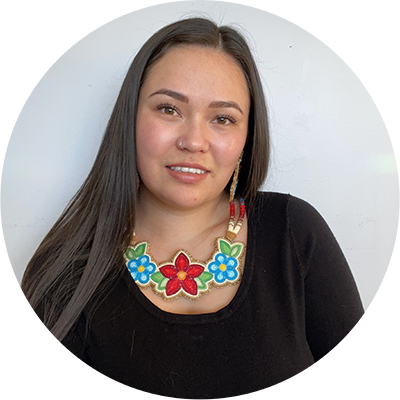
As members of the YAG, we are excited to share Canada’s first-ever SOYR. This report was shaped by youth from every province and territory in Canada. Engagement sessions provided youth with the opportunity to offer insights into their experiences, ideas and solutions on relevant issues and topics directly to governments. Together, 996 young people contributed to this report while bringing forward their lived experiences and opinions.
The youth-identified priority areas are Leadership and Impact; Health and Wellness; Innovation, Skills and Learning; Employment; Truth and Reconciliation; and Environment and Climate Action. We believe that the results of this report and the recommendations brought forward by youth deserve consideration and meaningful actions by all levels of government in Canada. The recommendations and ideas brought forward by youth in Canada in this report should be designed and implemented in partnership with them and their communities.
The YAG will advocate for the results of the SOYR to be communicated through digital and physical channels, so many more people learn about the perspectives and current state of youth in Canada.
We are optimistic that these are not the last conversations and actions that the government will take with and alongside youth. This report is a valuable tool for all governments to engage in dialogue and to work with youth to address the challenges and barriers that exist in Canadian society today.
We look forward to seeing how youth will mobilize in response to this report and how governments will aid them in responding to their needs, wants and desires. If recent world events and global movements have taught us one thing, it is that youth are not voiceless; however, far too often they continue to be ignored. Let us all use this as an opportunity to take action.
Introduction
Youth matter
As Canadians, we believe that youth have the right to not only be heard, but truly listened to and respected. They have a right to equal access to opportunities and supports. When youth reach their full potential, it benefits all Canadians.
“When the Wisdom Keepers speak, all should listen. So it is with youth: when youth speak, all should listen.”
Who are youth in Canada
The term “youth” generally refers to those in the stage of life from adolescence to early adulthood. Looked at numerically, there are over 7 million young people in Canada between the ages of 15 to 29, and they are as diverse as the country itself.
Youth in Canada come from a wide variety of backgrounds, with great diversity in their ethnicitiesFootnote 1, fluency in officialFootnote 2 and non-officialFootnote 3 languages and heritage. They express their identities individually and increasingly self-identify as belonging to certain groups. Canada’s youth are more comfortable and empowered to be who they are. For example, they more commonly identify as gay, lesbian, bisexual, and other sexually diverse identities, in comparison to other age groupsFootnote 4. Inclusivity is also strong amongst youth as a majority of youth have friends from diverse backgroundsFootnote 5.
In addition, youth are full of potential. They are more educatedFootnote 6 than previous generations, and for the most part, digitally well-connectedFootnote 7. Youth's share of the population is highest in the West and the North of Canada, predominantly in towns or large urban centresFootnote 8. Although less likely to vote, they are civically engagedFootnote 9, with youth contributing 23% of all volunteer hours. With these characteristics, youth in Canada are uniquely well-positioned to inform an innovative and inclusive future for everyone.
The stories and experiences of Indigenous youth are also very diverse, as are their languages and cultures. They continue to experience intergenerational trauma and must overcome enormous challenges to succeed in different spheres of their lives. Indigenous youth will shape and inherit the results of Canada’s reconciliation agenda, and play an important role in rebuilding relationships. They are key drivers of social and economic outcomes and their voices are ensuring that no new generation of Indigenous youth is "left behind".
Canada’s Indigenous population is not only youngFootnote 10, but the fastest growing population of young people in the country come from First Nations, Inuit and Métis communitiesFootnote 11. The number of Indigenous youth aged 15 to 30 increased by 39%Footnote 12, compared to just over 5% for non-Indigenous youth from 2006 to 2016Footnote 13.
The data and statistics presented in this report are mainly taken from Statistics Canada. That said, the Government of Canada recognizes the importance of Indigenous data sovereignty, which is the right of a nation to govern the collection, ownership and application of its own data. It acknowledges that the data offered in this report does not include data collected by different Indigenous communities and that the brief portrait presented here is incomplete. The Government of Canada supports First Nations, Inuit and Métis communities to design and implement their respective visions for data governance.
More youth also self-identify as Black (the number has grown to 5.4%Footnote 14). As a growing, civic-minded, innovative and engaged group, there is the opportunity for them to play an important role in designing the future of Canada. However, anti-Black racism remains a major obstacle to their well-beingFootnote 15. Black youth reported having negative experiences with law enforcement agencies, educational institutions, private companies, child services agencies, the judicial system and public services which, compounded, have limited their equal access to employment opportunities, educational attainment and equal and just treatment from systems that are supposed to serve and support them. Despite the significant barriers that have been created for them, Black youth have immense resilience as demonstrated by having a higher desire to achieve a university degree compared with other youth (94% vs 82%)Footnote 16.
What this portrait reveals about LGBTQ2Footnote 17 youth is also incomplete. Existing data suggests that a larger proportion of youth in Canada consider themselves to be either gay or bisexual, as compared with older Canadians (e.g., about 5% to 8% youth versus 2% to 3% of Canadians 31-64 years of age, respectivelyFootnote 18). Homeless Hub estimates that anywhere from 25% to 40% of homeless youth in Canada are LGBTQ2Footnote 19. However, significant data gaps on LGBTQ2 communities in Canada have contributed to a lack of information on LGBTQ2 youth, as well as the unique issues they face. Community engagement activities are underway to inform the development of the first federal LGBTQ2 Action Plan, including a national survey of LGBTQ2 communities. This will contribute valuable data points on LGBTQ2 youth and help to ascertain their realities and needs.
Implementing the Youth Policy
In 2019, the Government of Canada published the country’s first ever Youth PolicyFootnote 20. Thousands of youth across Canada leveraged a robust, inclusive process to weigh in on what matters most to them, and identified six youth priority areas:
- Truth and reconciliation
- Environment and climate action
- Health and wellness
- Leadership and impact
- Employment
- Innovation, skills and learning
The Youth Policy also established 3 guiding principles for youth policy implementation, and flagged select federal initiatives providing supports to Youth in Canada: Canada’s Youth Policy - Canada.ca
The Youth Policy affirmed the need for government to check in with youth at regular intervals, and this first State of Youth Report represents the cornerstone for delivering on this promise. It is the result of focused efforts to better understand youth in Canada and their priorities.
This State of Youth Report is primarily for Canada’s youth. In it, youth should see reflected their hopes and needs, and find programs and initiatives that begin to address them, with the acknowledgement that more needs to be done. This report is also for policymakers, who will develop a better understanding of the desires and expectations of youth in Canada as they call upon them to act. Finally, this report is for youth-serving organizations and adult allies across the country, enabling them to engage with their young people on the topics raised in this report.
What is important to youth today?
In 2020/2021, youth returned to their six priority areas identified in Canada’s Youth Policy as a framework for expressing what is important to youth today. Throughout engagement sessions held for this report, youth shared their perspectives on all priority areas, but clearly 2020/21 was a year like no other.
During this first year of the COVID-19 global pandemic, the health of youth was top of mind. Youth well-being has been dramatically affected in almost every aspect of youth experience. For youth aged 15 to 29, life satisfaction has not only decreased between 2018 and 2020, but it was the lowest among these youth than any other age groupFootnote 21. Additionally, one of the biggest impacts of COVID-19 and related public health measures (such as physical distancing and school closures) was on mental health, particularly for youth.
That said, this report is not dedicated to the global pandemic; youth continue to express their aspirations for the breadth of the priority areas first addressed in the Youth Policy. Youth are resilient: they are a diverse, educated, well-connected and engaged population. They have been particularly challenged by the global pandemic and the insights that they share in this report are coloured by their experiences with COVID-19, but they are not limited by it.
How youth were engaged to produce this report
While an in-person model of youth outreach was originally planned, early State of Youth Report engagement quickly adapted to the new reality imposed by the COVID-19 pandemic. With a continued focus on youth who face barriers or are less often engaged in public discourse, plans were modified to speak with youth virtually, wherever they were at. Despite the challenging contextFootnote 22, youth across Canada rose to the occasion. From August 2020 to May 2021, nearly 1000 youth from all over Canada contributed their experiences, perspectives, insights and expertise.
Research protocol summary:
- Strong research ethics protocolsFootnote 23, to work with youth in good way
- Semi-structured, facilitated online discussions
- 90 sessions hosted by youth-serving organizations, youth facilitators and/or adult allies
- Preferential recruitment of youth facing barriers, those with highly intersectional identities and youth who are less often heard
- Youth included through individual response forms when bandwidth or logistics posed a challenge
- Over 50,000 qualitative data points generated by youth participants
- Qualitative analysis using a Grounded Theory approach [see Annex A- Glossary of terms]
Youth participants also contributed information about themselves through an optional demographics form. Youth across Canada affirmed multiple, intersecting identities when it came to: their Indigenous identities, race, ethnicity, education levels, languages spoken, place of residence, disabilities, mental illness, and identities as LGBTQ2Footnote 24, newcomer/immigrant, youth in care of child welfare authorities, and other distinctions.

During engagement sessions, youth used guides containing Statistics Canada data infographics to stimulate conversation. Youth responded, generating valuable qualitative data. Their perspectives often challenged the information that was presented to them (see Annex B – Spotlight on Engagement Data). Participant responses formed the evidence base for the “State of Youth 2021 - in their own words” section of this report. Furthermore, all quotes that follow were provided by youth during those sessions.
What to expect in this report
This report reflects a commitment and support for youth in Canada. Most importantly, however, this report crystalizes a diversity of youth perspectives and critical thinking, grounded in youth data and expressed by youth themselves. These perspectives are presented in their recommendations, as well as in the illustrations that appear throughout, which are visual interpretations of the priority areas made by young artists specifically for this report. As the State of Youth Report aims to amplify youth voices and self-determination, the words in the following section “The State of Youth 2021 – in their own words” are indeed their own - unfiltered. It is also important to note that youth are affected by, and have views on, all issues affecting our nation – not only those that are typically deemed “youth issues”.
The reader will note that this is not a typical government document. As its title indicates, the State of Youth Report is intended for youth, was informed by engagements with youth and also contains a significant portion drafted by youth. The following groups of youth were engaged in the writing of the State of Youth Report:
Youth authorship of the State of Youth Report
The SOYR Youth Advisory Group (YAG):
- 13 young people identified through partnerships, reflecting Canada’s diversity
- convened to interpret the engagement data and draft The State of Youth 2021 - in their Own Words portion of the report
- not representatives of any group, but as leaders with valuable lived experiences and perspectives
The Prime Minister’s Youth Council (PMYC):
- worked to publish the Youth Policy in 2019
- helped create the engagement guides
- collaborated with the YAG to draft the report
Youth Members of the federal Director General Committee on Youth:
- contributed feedback and information supplements regarding Government of Canada policies, programs and initiatives supporting youth according to the six priority areas
Young Artists:
- youth expressed early on that words are only one way of expressing complex ideas
- six diverse young artists were commissioned to create visual interpretations for each priority area, to complement and punctuate the words shared in this report
As promised in Canada’s Youth Policy, select federal initiatives designed to support young people are highlighted to help raise awareness of programming available to youth. They are provided in call-out boxes to interfere as little as possible with the perspectives expressed by youth.
The members of the Youth Advisory Group have grappled with the youth data for each of the six priority areas, and they have leveraged the opportunity to make a number of recommendations. Embracing the first Policy principle whereby “Youth have the right to be heard and respected”, here is The State of Youth 2021 – in their own words.
The state of youth 2021 – in their own words
Truth and reconciliation

My piece revolves around Reconciliation and what it has meant to us as Indigenous People. I wanted to show the activism and protests for reconciliation over the decades in Canada. I drew inspirations from the activism and protests I saw when I was a child, and the ones that I have been a part of, or ones that had happened near my community.
Introduction
Reconciliation is not a task to be completed, it is a vision for a society where past and current injustices are recognized and addressed. The process of reconciliation must entail significant changes in order to offset the history and current reality of racism and colonization in Canada. The governmentsFootnote 25 must hold themselves accountable for the past genocidal actions of previous governments and their horrific impacts (historically and presently, including intergenerational trauma) on the Indigenous communities of Canada. The governments are responsible for creating opportunities to form good relations with Indigenous communities, to facilitate trust and to improve the quality of life of Indigenous Peoples.
COVID-19
During the COVID-19 pandemic, pressures on Indigenous communities have increased, causing the amplification of existing problems and the creation of more. Students were required to participate in online learning, and for the many Indigenous youth affected by the current infrastructural and housing crisis, this online learning could be occurring in unsafe living conditions. This makes it difficult for young people to access learning and to concentrate on it in their homes. Additionally, addictions, abuse, and the number of suicides has become more frequent in Indigenous communities. Lastly, the pandemic has limited consultations, engagements, and communications with Indigenous communities.
“Stay home stay safe, but what if your home isn't safe?” Footnote 26
Citizen responsibility
Every Canadian has a role in the reconciliation and un-colonization process. This shared commitment must be rooted in Indigenous experiences and spearheaded by everyday actions. The act of reconciliation will only be achieved with the participation every inhabitant of this land.
“It’s not an Indigenous only problem, we are all in the problem and the solution.”
Attainability
Youth in Canada have mixed feelings about whether reconciliation is possible. Previous unfulfilled government commitments and a lack of change and action has led to frustration and distrust. In order for youth to believe that reconciliation is possible, the governments must continuously take action to improve the quality of life of Indigenous Peoples. Youth want to see Canada develop an action plan that is measurable and relevant in order to hold our systems and institutions accountable. Indigenous Peoples should be engaged when determining this measurability and relevance.
“I believe there is still a very long ways to go and it is important that all Canadians remember that reconciliation will never be “over” and that it is a lifelong journey and learning process.”
Indigenization
Youth want the governments to acknowledge the fact that Canada was built on colonization and continues to thrive off of it today. The governments sustain and perpetuate some of the most pernicious effects of colonization. We will not be able to move forward and progress as a society until we understand the truth about what really happened when settlers arrived, and who was here before their encounter. The governments must take responsibility and act in a way that deconstructs colonization. Land is an imperative part of Indigenous sovereignty and it plays an enormous role in their way of life, beliefs, and vitality. The governments should put the power of land stewardship back in their hands. Until the land is returned to Indigenous Peoples, colonization continues. Listening to Indigenous Peoples and being accountable to their truths is foundational. We must Indigenize our country by integrating Indigenous practices into our society. The mistrust, lack of action, and the governments’ ongoing use of blanket terms hinders the youth’s optimism towards reconciliation.
“Would like to see the government acknowledging that Canada is built on colonization to actually recognize the truth.”
Healthcare
Across every parameter, Indigenous Peoples have poorer health outcomes and higher rates of morbidity and mortality than any other identifiable group in Canada. Reports of poor treatment by healthcare staff demonstrate the systematic racism towards Indigenous Peoples that is embedded into the Canadian healthcare system. The present infrastructure is not adequate to meet the current needs of Indigenous communities. Every Indigenous nation must be included in government supports. The lack of access to mental and physical health support is detrimental. Additionally, too many Indigenous communities do not even have access to clean water. This leads to a magnitude of individual and community-wide health issues. When interacting with the health care system, such as during hospital visits, biases, racism and discrimination are prevalent, which results in poorer health care services and negative health outcomes.
“There is an urgent need for counsellors for Indigenous youths, highly understaffed.”
Education
Education and awareness are the foundations of reconciliation. Indigenous Peoples in most northern and remote communities continue to face a major gap in education and training. Indigenous People in these regions experience a lack of choice in K-12 and degree granting institutions. In turn, this lack of available education forces Indigenous People and especially, Indigenous youth to relocate to areas with little to no familiar supports.
Along with addressing gaps and barriers to Indigenous education, every single inhabitant of Canada needs to learn about the true history of Indigenous Peoples and what happened when this land was encountered, such as land theft, residential schools, murder, the Sixties Scoop, food sovereignty, and the current living conditions in Indigenous communities. A mandatory Indigenous history curriculum within all the education systems would substantially facilitate the progress of reconciliation.
"I know a lot of people tell me they heard nothing in school, I’m sad but not surprised to hear that.”
Language preservation and vitality
Indigenous languages represent an enormous part of Indigenous cultures and need to be protected, taught, and celebrated. The cultural assimilation that has led to the loss of these languages has caused a catastrophic deficit in knowledge, tradition, and connections to ancestry, which together catalyzed and facilitated the horrific consequences of the colonization of this land. Decolonization must include the rematriation of languages in order to begin to address the damage caused by residential schools and the cultural decimation that Indigenous Peoples faced.
“It should be free to learn Indigenous languages as it was taken away from Indigenous Peoples.”
If youth are interested in exploring government programs related to Truth and Reconciliation, below are some examples:
- The Canadian Roots Exchange pilot program seeks to bring together Indigenous and non-Indigenous youth to promote reconciliation, mutual understanding and respect. This is a direct response to Call to Action (CTA) Number 66 of the Truth and Reconciliation Commission (TRC). Visit the Canadian Roots Exchange to learn more.
- The Indigenous Community Support Fund provides Indigenous leadership with funds to respond to COVID-19 in their communities. Visit Indigenous Services Canada to learn more.
Truth and reconciliation recommendations
Governments must...
- COVID-19
- Offer substantially more mental health support to Indigenous communities.
- Including therapists, social workers, and school counsellors.
- Ensure a higher quality of life in Indigenous communities by increasing and streamlining infrastructural capacity projects for physical health resources, creating additional spaces such as walk-in clinics, addiction centers, and community supports.
- Offer substantially more mental health support to Indigenous communities.
- Citizen responsibilities
- Create opportunities for nation-wide participation in reconciliation through community-based programming and organizational/institutional training.
- Indigenization
- Return Crown land back to Indigenous Peoples.
- In the case of not being able to return land back, the Government of Canada must unconditionally support Treaty Land Entitlement claims and all other Land Surrender claims.
- Take accountability for actions past, present and future.
- Support each Indigenous nation in their right to self-governance, without exception.
- Return Crown land back to Indigenous Peoples.
- Healthcare
- Stop ignoring and strongly address the blatant mistreatment of Indigenous Peoples in healthcare.
- Institute severe consequences for neglectful and harmful attitudes and actions from healthcare workers towards Indigenous Peoples.
- When an incident occurs, there must be a full, independent, unbiased investigation.
- Work to embed mandatory Indigenous Cultural Awareness training for ALL staff and faculty within the healthcare system.
- Education
- Work to embed Indigenous history and cultural education into all curricula across the country.
- Create opportunities for all students who lack them, to experience Indigenous culture and understand the past and present, traumas and strengths.
- Provide greater investments in Indigenous schools in order to facilitate their success and prosperity.
- Encourage and support access to post-secondary education
- Supports such as childcare, transport, and mental health services must be offered.
- Language preservation and vitality
- Prioritize the teaching and protection of Indigenous languages.
- The government must fund and implement a thorough investigation of all former residential school grounds to ensure recovery of any deceased children, found in unmarked mass graves or elsewhere.
- All remains found must be identified and returned to their communities and families.
- The people responsible for the crimes of sexual, physical, emotional, spiritual, cultural abuse of Indigenous children must be charged and held accountable.
- A full and detailed report of the completed investigation must be published, sent directly to affected communities, and made available to the public.
Conclusion
In conclusion, it is clear that a report like this could never encompass all of the work that needs to be done in order to reconcile between non-Indigenous and Indigenous communities of Canada. However, these thoughts are what the youth believe to be the next steps. The Canadian governments must work towards a trusting relationship with Indigenous Peoples, they must help communities in these times of pandemic, create concrete action plans and ways to be held accountable to it. We need to address the racism in healthcare, and we must implement an education that values Indigenous ways of being and learning.
Environment and climate action
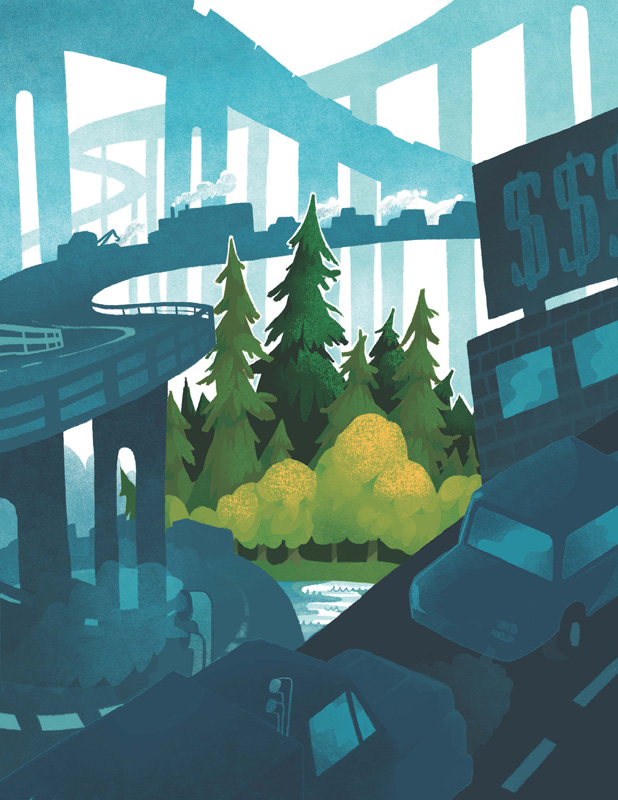
For the Environment and Climate Action priority area, I wanted to express my own thoughts on the subject, but also some of the issues brought up in the report. I feel very strongly that climate action is of the utmost importance, and that governments everywhere could be doing more to reach climate action goals. I understand now that this is a privilege. It was eye opening to discover that accessibility was a major issue for many youth, and that meeting basic needs is difficult enough. Attitudes of apathy and inaccessibility are the major themes of my piece, and yet I wanted there to be hope – hope that we can turn things around for everyone (especially Indigenous communities around the world who are disproportionately affected by the effects of climate change, while contributing the least), if we can focus our efforts – together.
Introduction
The climate crisis is one of the most important issues that our generation faces. There are different facets of the climate crisis and in turn, different facets of solutions and answers. The climate crisis is a result of years of putting profits first and people and their well-being second. In many places across colonized Canada, you can see the effects of climate change and global warming now. We need radical, meaningful action that helps everybody out of this crisis and establishes changes that will put the earth first. During the engagement sessions, youth have talked about their reflections, concerns, and ideas regarding the crisis and the response to it.
Privilege
Racial privilege and socio-economic privilege are often discussed to demonstrate the impact of systemic racism on people’s socio-economic outcomes in their communities. It takes quite a bit of privilege to be able to focus on being environmentally conscious and sustainable versus only on getting the basic necessities, no matter how unsustainable. We also cannot forget that many people simply are not able to spend their time volunteering because they cannot afford it. Climate organizations generally, and not-for-profits specifically, are led by and made for white people and are structured in a way that leaves out marginalized youth.
“It is kind of like a privilege to volunteer with environmental organizations in general because there are youth who don’t even have food on the table. You have to have your own needs met before you can start helping and unfortunately a lot of youth don’t have that right now.”
Finally, one point that was brought up more than any other during the engagement sessions was the lack of trust and support offered to youth who are involved in climate action. Youth describe feeling laughed at, or discriminated against or plainly not taken seriously by the older people around them, teachers, parents, professors, etc. As a result, youth had less of a desire to participate in climate action.
“Some other things: youth income inequality and barriers to leadership as well, since youth with lower resources don’t have as much time or won’t be aware of as much opportunities to get involved [in climate action] since they have a lot more responsibilities.”
Location
The impacts of climate change vary based on an individual's location; in addition, location impacts an individual's ability to participate in climate action. Many respondents indicated feeling some isolation, especially in rural areas, regarding climate action. In smaller, more rural communities, there are a small number of groups who participate in climate action. In addition, recycling programs or community gardens may be more difficult to maintain or get underway. Location also has a clear impact on the amount one person might use a vehicle as opposed to public transit.
It is also clear that some communities often have poorer health outcomes as a direct result of their environment. Corporations or governmental actions often lead to serious changes in ecosystems and disrupt many communities further down the line, both in terms of future generations and through nature itself.
“Montréal dumped trash in the river, without thinking about how they affect other communities. In that case, it went to Quebec and other cities.”
It should also be noted that Indigenous communities often have the worst health outcomes in the country - often due to polluted water ways, change in natural habitats and general lack of support and infrastructure. Pipelines and corporations use Indigenous land as dumping grounds that disproportionately affect the health of Indigenous Peoples. Land Defenders like in 1492 Land Back Lane have had to protect their land from pipelines like the Tsleil-Waututh nations against Trans Mountain Pipeline Expansion or protect their treaty rights as is the situation with Mi’kmaw fishermen in Mi'kma'ki. Not only for the sake of the environment, but for the sake of preservation of tradition and sacred land.
Education
Education is, of course, a necessity when discussing environment and climate action. A main reason for this is the result of new information as well as misinformation coming out on the topic all the time.
Although some teachers or schools cover climate change, it is often old information that does not accurately portray the urgency and the different facets of the crisis, and it is often taught in a rushed manner. This means that youths are often left to their own devices when gaining access to new and more up to date information on the topic. As a result, youth turn to the internet and social media, but we must also note that many young people do not have access to internet at home. This, in turn, leads to increased inequality and divide with who can participate in the climate change discussion. Despite its benefits, social media can also lead to misinformation and over-simplification.
Education on this topic is also important once people are no longer in school. There is a need for more young adult programming, outside educational institutions, on the subject as well as community building. Some respondents mentioned more community gardens popping up since COVID-19, which is wonderful to see! There is definitely a need to make these types of programs more accessible and possibilities for funding for communities that want to offer educational activities on environment and climate action to create better and more sustainable communities.
“Littering is terrible and Newfoundland just got a recycling system. The litter goes to the ocean. People don't know how to manage their waste because of the aging population so nobody grew up recycling so people don't know how to do it.”
Sustainability
Sustainability refers to the idea of supporting our needs today while preserving the future’s ability to provide for their needs. According to the Climate Action TrackerFootnote 27, Canada is not on track to reach the Paris Agreement goals, meaning net zero carbon emissions by 2050 or keeping the temperature 1.5°C above pre-industrial levels. There is a rising push from scientists and youth advocates that the Paris Agreement goals are not ambitious enough, we actually need to be net zero by 2030.
Resources are central to the idea of sustainability. Canada has been reliant on one resource that is dooming us: oil and gas. Instead of continually investing in finite, carbon-filled resources, we should invest in cleaner sources of energy to which we have access. Let us use our resources to their fullest abilities and use them wisely. It should also be noted that other industries, not mentioned above also have far-reaching impacts on the environment that cannot be properly addressed in this document due to their complexity, such as deforestation, aquaculture and unsustainable agricultural practices.
“Socio-economic status plays a part. Being sustainable can be expensive, not accessible to everyone.”
When we talk about sustainability, we need to make good government choices for industry and people. The root cause of the climate crisis has been greed, corporations and lack of government regulations, not individual actions. The climate crisis can only be solved with an overhaul of the system, not individual actions.
Government
The Canadian government and its policies play an important part in climate action. The government has the responsibility and the ability to impose regulations on corporations and industries. The government must disclose its relationships, and collaborations, with corporations, and must enforce rules for themselves and other industries to be transparent about their carbon footprints and dealings.
The government also promised to respect Indigenous sovereignty, a key part of taking care of the land and fixing the broken system that has perpetuated climate change. The continuous push for pipelines comes at the expense of Indigenous communities, their safety and their sovereignty.
The politicization of the climate crisis has discouraged politicians from pushing for climate action. From a youth’s perspective, many adults around them do not view the environment as a priority and see it as an obstacle to a flourishing economy. Conversations about the climate with youth have been used as tools to increase candidate popularity within youth demographics.
“It can be really disheartening to be sharing your opinion and putting all this labour into ideas for improving the system… and then not really seeing it go anywhere.”
Youth are an important part of our landscape and we must treat them as the key stakeholder and rights-holders that they are.
“If youth are going to give up their time and their energy to give their opinion, they need to be shown that it’s not just going into the void… Take the ideas into account and actually do things with them.”
COVID-19
Pandemics, like COVID-19, will only become more common as the climate continues to warm. COVID-19 has been a sharp reminder about how the world will be impacted, socially and economically.
“[COVID-19 was] a big pause brought to us by nature that the world needed to take a breath of fresh air, for things to calm down and nature to truly thrive.”
Lockdown allowed us to spend more time at home and less time on the road, resulting in a lowering of carbon emissions for a period of time. On the other hand, more single-use plastics from masks and grocery store bags are being used which has increased pollution.
For years, governments have told us that we cannot move away from fossil fuels because our economy just does not allow it, but we were able to see a spike in support of local businesses and monetary support from the government. The pandemic has also shown us that a shift is possible and changing our way of life and economies are adaptable: if we can adapt for COVID-19, we can adapt for climate change. COVID-19 exacerbated the problems in our system, ones that have and still are contributing to the climate crisis. It is important to note that COVID-19 is an international issue, similarly to climate change, there needs to be leadership at all levels to have meaningful change.
If youth are interested in exploring government programs related to Environment and Climate Change, below are some examples:
- The Science and Technology Internship Program (STIP) and Science Horizons Youth Internship Program provide incentives to employers to hire natural sciences and engineering graduates to gain experience. Visit Green Jobs in Natural Resources Canada to learn more.
- Budget 2021 proposes to provide $17.6 billion towards a green recovery to create jobs, build a clean economy, and fight and protect against climate change. Visit Government of Canada Budget 2021 to learn more.
- The EcoAction Community Funding Program provides financial support to non-profit and non-government organizations for local action-based projects that produce positive effects on the environment. Visit the Government of Canada EcoAction Community Funding Program to learn more.
Environment and climate action recommendations
Governments must...
- Implement just transition principles into its policies.
- These policies will transition our economy and labour away from fossil fuels and into the green sector, while uplifting our most vulnerable.
- Re-train and re-tool workers of climate-catastrophic industries like oil and gas and fossil fuel industries into green jobs.
- COVID-19 gives us the opportunity to restart our economy and help it recover, through a Just Recovery with the basis of a Just TransitionFootnote 28.
- Invest in green technology and prototypes that are developing alternate solutions to our increased carbon footprints.
- Work with community and family farmers to develop environmentally-sustainable farming.
- Just and Green recovery that places, at its centre, marginalized people who have been negatively impacted by the system and building a system with safety nets and green basis.
- Create accessible grants for community projects geared towards environmental education- such as community gardens, solar farms, composting initiatives and more.
- Community organizing should be supported, since that is where change is most impactful.
- Offer increased grants for community projects.
- Subsidized projects to lower the cost of long-term green initiatives (e.g.,: community solar farms) and community education initiatives.
- Promote Indigenous sovereignty.
- Treating Indigenous nations as nations and supporting them to practice their traditions and cultures is essential to the betterment of the environment and our system.
- Stop pipelines, especially ones that go through Indigenous territories.
- Support Indigenous groups and communities by enabling the leadership opportunities required to do what they think is necessary.
- Give Crown Land back to Indigenous groups.
- Work with NGOs and other environmental organization to make participation accessible.
- Governments must support existing youth organizations and spaces, instead of creating their own.
- Give honoraria, and reimbursement for the time and effort of people who help guide policy and change.
- Encourage participation opportunities in any capacity, especially outside of school to allow more youth to participate.
- Marginalized people must be provided safe and inclusive spaces so that they may provide impactful change for their communities.
Conclusion
The climate crisis has manifested itself in all areas of our world and continues to impact our lives and livelihoods, especially to the younger generations. We must listen to scientists, and Indigenous elders. We must follow their knowledge, and their solutions. The government needs to follow up on its promises and hold itself accountable. It has become clear that youth do not just want mediocre action; they would like ambitious climate action where youth and marginalized groups are at the center of the solution. Climate change is a crisis, and we must treat it as such, using all of our resources and abilities.
Health and wellness

This year has been hard on everyone. It has been a constant struggle: stumbling, crashing, submerged and washed away under pilling concerns and a sea of worries. In this piece, I wanted to portray this burden. Whether it is due to the pandemic or another circumstance, taking care of ourselves is important. The wellness priority area spoke to me because our mental health is a major part of our well-being and it is imperative to give it the attention that it needs. I decided to illustrate hands around the subject to depict our loved ones as well as our own strength as we support each other and heal. The flowers growing throughout the piece portray this healing. The chrysanthemums symbolize the loyalty and devoted love we find in our support system; the lotuses depict a journey through darkness and pain, leading towards self-regeneration, rebirth, and enlightenment. We are constantly losing and finding ourselves. I hope this piece speaks to the viewer, allowing them to reflect on their own journey and interpret this in their own way.
Introduction
The health and wellness data demonstrate the unique ways young people in Canada experience the healthcare system. Youth face many barriers and inequalities due to their identities, inaccessible and costly healthcare, a lack of strong support systems particularly in the midst of the COVID-19 pandemic, insufficient education on mental health, physical well-being and an overall lack of extensive and culturally responsive resources.
Access to healthcare
Youth across the board struggle to access healthcare. Youth from low socioeconomic households face difficulties taking time off work to attend appointments.
Additionally, transportation is a serious concern for youth in rural or reserve communities, as it is often inaccessible or too expensive to commute for healthcare and mental health needs.
“Cost is a big one as well. We like to think that our health care is largely free. Going to a doctor has got out of pocket costs for the majority of us, it’s missed work, missed school, transportation.”
In terms of technology, there are challenges around accessing virtual healthcare particularly during COVID-19. More online and tele-health format services are needed to resolve geographical location barriers for many youths. In order to do so, the digital divide must be addressed to ensure access to affordable technology and internet connection in all communities.
“To me a healthy lifestyle/community means you have supports that match your needs and culture (not just western supports). It’s a community where people support each other and has access to the resources to meet their needs and have time/ funds for recreation.”
Equity and social determinants
There are a variety of factors that youth feel contribute to healthcare inequities including: marginalized identities, ableism/racism/classism/sexism, geographical location, lack of culturally responsive resources, inadequate nutrition and wellness education, food insecurity, etc.
“Social classes should be considered when collecting data because it can affect one’s access to healthcare.”
Visible minority youth, Indigenous youth, those from rural and remote communities, linguistic minority youth, youth with disabilities and LGBTQ2 youth do not have proper access to healthcare. Many could not access a physician due to geographical location, and others encountered biases in the healthcare system. Additionally, few services are offered in French outside of Québec, which is detrimental to the many francophone youth in official-language minority communities in Canada. Other factors contributing to inequities are food and economic insecurity, a lack of resources for unhoused youth, and a lack of mental health infrastructure in rural communities.
“Transportation, housing, food security… doctor tells you, you need to get healthy but low income have less access to healthy grocery stores. Easier access to junk food.”
Physical health
Instead of weight, youth felt that nutrition, fitness, mental health and wellness are better indicators of health, so these should be the focus during check-ups. Youth believe there is a need for complete healthcare access including: vision, dental, prescriptions, and mental health services, and that a balance must be struck between work and physical and mental health. Further, youth with disabilities face many barriers within the healthcare system especially with receiving proper diagnoses and finding supportive healthcare practitioners who understand their needs.
“For Canada’s youth, supporting health means providing opportunities to things like healthy food, activities that promote exercise, other people, and a safe place to de-stress."
Nutrition is heavily influenced by location, as those in rural and reserve communities have a difficult time accessing affordable healthy foods which impacts their physical and mental health. Due to the pandemic, accessing food banks has also become a challenge although the need for these resources has increased. Within urban areas as well, accessing affordable healthy foods can be a challenge especially in areas known as “food deserts”.
Mental health
Throughout the engagement sessions, it became evident that there is a mental health crisis impacting many youth in Canada. Youth mentioned that the lack of mental health education and accessible resources has led to continued stigma around mental health. Further, social media trends are identified as a concern among youth as well, as several individuals mentioned they were dealing with body image issues as a result of the content they were exposed to online. Additionally, an important point surrounding the safety of minors and privacy was mentioned, since the school has a legal duty to inform parents if their child is in crisis:
“Getting support for mental health support is hard because the parents are always involved. The parents don’t always understand the extent to which their child is suffering, therefore, communication is hard. Youth would be more comfortable to express what they are feeling if their parents weren’t involved.”
Students mentioned teachers and staff should receive better mental health training so they can assist youth and refer them appropriately. There is especially a need for better support for youth that are affected by bullying, an issue which disproportionately impacts people of colour, LGBTQ2 youth, youth with disabilities and those from marginalized communities, including linguistic minorities. Individuals also noted that there are long wait times to speak with counselors, and financial privilege associated with accessing private mental health care.
Systemic issues such as a lack of culturally responsive services and transportation for rural youth create additional obstacles. Further, the current system has created distrust among vulnerable, marginalized, Indigenous, and LGBTQ2 youth and youth with disabilities who may not feel safe accessing care due to unequal treatment in the healthcare system. Overall, many factors have an impact on mental health such as, socioeconomic status, food insecurity, substance use, etc.
“A huge step would be to see under universal healthcare cover mental health services, especially for youth, and having counsellors of all different backgrounds so you can see your own culture reflected in the professional helping you.”
COVID-19
COVID-19 has many negative consequences on the mental and physical health of youth. Specialists are difficult to access for remote and rural youth, and quality of healthcare is decreasing and is no longer a guarantee. Online health services are limited in scope and effectiveness, and miscommunication due to connectivity issues has been raised as a concern. There has also been a sharp decline in physical activity due to gym closures and a lack of green spaces in urban areas.
In terms of mental health, isolation and a lack of support systems led to negative mental health for many youth due to loneliness, work-life imbalance and uncertainty around the pandemic and future. Further, several challenges arose with stay-at-home orders for those who are unsafe at home. This has resulted in an increase in child abuse, as well as food insecurity; since schools are closed there is limited access to school-led food programs for youth, and LGBTQ2 youth who live with unsupportive or unsafe family members are at an even greater risk as they are cut off from support systems. Speaking openly in virtual mental healthcare sessions has also been difficult, due to a lack of safe spaces for some.
“For some – financial instability, social anxiety and isolation, fear of the unknown, anxiety for those with compromised immune systems or caring for someone in ill health, lack of physical exercise, depression/loss of motivation, extreme shut-downs in group homes leading to more limited personal freedom and mobility, CERB/EI not enough to survive, just covering rent.”
If youth are interested in exploring government programs related to Health and Wellness, below are some examples:
- Kids Help Phone is a 24/7 national service offering confidential counselling, referrals and supports to young people in both English and French. Visit Kids Help Phone or call 1-800-668-6868 to learn more.
- Wellness Together Canada is a cost-free mental wellness portal. It connects Canadians to mental health professionals for confidential chat sessions or phone calls, and offers information, tools and resources. Visit Wellness Together to learn more.
Health and wellness recommendations
Governments must...
- Provide health and wellness education to youth.
- Utilize an intersectional lens to raise awareness around healthy lifestyles, provide education on nutrition/wellness and to reduce stigma around mental health through the school and healthcare system.
- Establish youth-targeted substance use prevention resources.
- Ensure cross-sector collaboration among ethnic media, service providers and health practitioners in order to address cultural stigma.
- Provide educators with mental health and substance use training, so they understand warning signs among students and assist in appropriately referring them to resources and additional help if needed.
- Educate youth on using social media in a positive way to reduce detrimental impacts on mental health, and to develop cyberbullying prevention strategies as usage of these apps has increased due to COVID-19.
- Utilize an intersectional lens to raise awareness around healthy lifestyles, provide education on nutrition/wellness and to reduce stigma around mental health through the school and healthcare system.
- Address systemic issues in equitable access to healthcare and wellness.
- Establish more culturally responsive and multilingual mental and physical health resources which reflect the populations they are serving.
- Health practitioners should receive sensitivity training in order to ensure they provide effective and high-quality care to LGBTQ2 youth, racialized and marginalized youth, at-risk youth and people with disabilities.
- Provide publicly funded, affordable and accessible healthcare access that includes: vision, dental, prescriptions, and mental health services.
- Provide affordable healthy food options, clean water and low-cost public transportation to youth in rural/remote and reserve communities so they can access health care services.
- Increase tele-health services across all communities to reduce wait times, and provide affordable high speed internet connection across all communities.
- Create laws and regulations which permit youth (at least 16+) to access mental health services without the involvement of their parents.
- Ensure that the development of national standards for access to mental health care for youth are informed by youth through an intersectional lens.
- Recognize the effect COVID-19 has had on overall health.
- Create more green spaces especially in urban areas to encourage physical activity.
- Collaborate with schools and local service providers to provide more reliable mental and physical health supports for youth due to social isolation.
- Provide supports and safe spaces for at-risk, vulnerable and marginalized youth who are unsafe at home.
Conclusion
From the engagement sessions, it is evident that youth across Canada have been facing difficulties in accessing healthcare both pre-pandemic and during. Youth from marginalized communities, youth with disabilities, LGBTQ2 youth, those from remote areas, youth with disabilities, and Indigenous and visible minority youth have been disproportionately impacted by barriers to healthcare. Overall, intersecting factors such as ableism, racism, classism, sexism, homophobia, transphobia, ageism, geographical location and more have contributed to healthcare inequities. In order to increase access to healthcare, there is a need for: more education around healthy lifestyles and in reducing mental health stigma, culturally responsive resources, the healthcare system to be analyzed from an intersectional lens to understand what barriers to access exist for vulnerable groups, so that accessible, affordable, efficient and holistic healthcare services can be provided across rural and urban communities.
Leadership and impact
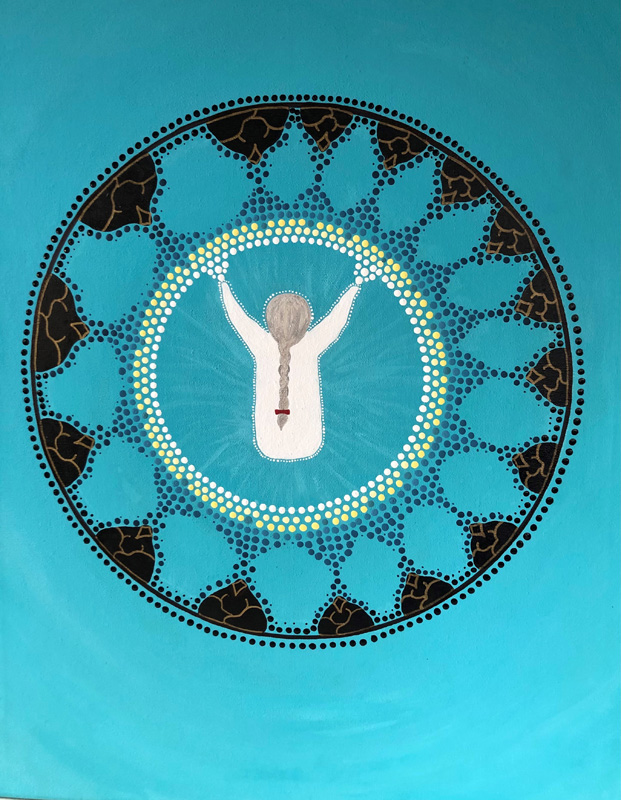
The priority that I was fortunate to model through my art piece was Leadership and Impact. This topic is important to me because I try to emulate leadership in my own life and hope that I can be a positive impact for others. This art piece is unique in many ways – the dot art is used to symbolize the intangible exuding of knowledge and leadership from the person in the middle toward the people sitting cross-legged around the circle. They are of various sizes to represent those who are in different stages of their own journeys and also references the four stages of the medicine wheel. The colours change as the perception of impact translates between provider and receivers while also connecting those next to one another.
Introduction
Throughout the engagement process, youth expressed how important leadership opportunities are to them, and the value these opportunities give youth. Some of the key themes that emerged include: what leadership means to youth, how equitable and accessible leadership opportunities are, and how COVID-19 has impacted youth and their leadership opportunities. Youth also described their interactions with both the Government of Canada and the education system.
Leadership takes many forms
For youth, leadership has many forms. It is not just creating change at a large scale, it is also informal actions that make positive change. While some are involved in politics, public speaking and community initiatives, other leaders solve problems, encourage peers, check in and take care of others, as well as protect their communities.
“Rural communities with less resources and higher proportion of the population being 65+, creates disenfranchised youth from a lack of opportunities for youth.”
Accessing the opportunity to make a difference
Many individuals note that not everyone has access to strong connections and networks in order to secure opportunities. Additionally, unpaid work is not accessible to low-income youth who cannot afford to volunteer, and in-turn this denies them leadership and networking opportunities. Accessibility to opportunities was also recognized as being a challenge due to, for instance, commuting and lack of public transit in rural areas, gender identity, language and cultural barriers and technology access. Further, youth emphasize that there needs to be greater investment in their futures, in areas such as employment opportunities for young people with disabilities and those with other marginalized identities. Overall, it was agreed that these gaps were widened further because of the pandemic, since support did not exist for these vulnerable individuals prior to COVID-19.
“Unpaid work puts low income youth at a disadvantage, deprives them of leadership and networking opportunities.”
Taking youth seriously and opportunities with government
Youth are concerned with authority figures’ misuse of power (specifically the police). It is important to acknowledge and recognize the harm that police in Canada have caused marginalized youth, their families and their communities. While youth feel positive relationships with police are important, the police first must be defunded and powered-weaponized before constructive conversations on reshaping the system and building positive relationships can occur. As well, youth want to be more involved across governments and have more opportunities to grow as leaders and sustain leadership opportunities. Furthermore, youth want to participate in the decisions that affect them and want those in the government and others to acknowledge and recognize their agency and autonomy. To give youth greater agency and participation, it is important that the voting age in Canada be lowered from 18 to 16.
“I live in Yellowknife and lived in Inuvik in the past and I've noticed that more than anything there's a sort of mental/emotional and geographical barrier. A lot of my friends don't feel as though their outlook is too important in terms of Canada as a whole, mainly because of where we live and how it seems as though a lot of people don't really know much about up here (and Nunavut included).”
Employment, education and credentials
Youth note that the importance of higher education in the current job market and economy makes it extremely difficult for those youth who face barriers to post-secondary education to find a meaningful path to employment or leadership opportunities in their community. Youth recognize that education is an enabler, because it provides credentials and employment opportunities, but it’s equally a barrier, as not everyone has equitable access to pursue education.
“As a barrier, meaningful leadership opportunities are sometimes directed solely for youth in school without consideration of youth not in school or requires decades of experience without a chance for new leaders to come to the table.”
Impacts of COVID-19
Especially during COVID-19, youth have had a difficult time maintaining social connections and relationships with peers, leading to increased feelings of loneliness and anxiety. However, youth recognize school clubs, youth organizations and leadership opportunities as sources of inspiration, hope and quality engagement, and as places where leadership can grow and marks can be made.
“Volunteer opportunities are mostly found through the internet, and there are still many youth both on reserves and in rural communities that don’t have access to these resources.”
The COVID-19 pandemic has brought about many different challenges for youth, from what is now being known as ‘Zoom fatigue,’ to internet connectivity issues in rural or reserve communities. Interacting virtually has made it particularly difficult for youth from cultural communities, whose cultural celebrations have become a shadow of what they used to be as a result of virtual adaptations.
LGBTQ2 youth are finding it difficult to access safe virtual spaces, putting them at greater risk. Barriers have also been present in areas such as finding volunteer opportunities and managing financially due to job losses. But COVID-19 has also had its positives for youth, leading to an onslaught of creativity and creative ways of doing things, as well as giving youth the opportunity to get virtually involved with issues beyond their community, province, and even country.
If youth are interested in exploring government programs related to Leadership and Impact, below are some examples:
- The Canada Service Corps offers meaningful volunteer service opportunities for youth to have positive impacts in their communities. Visit Canada Service Corps to learn more.
- Youth Take Charge supports youth to be active and engaged citizens through youth-led projects in communities. Visit Youth Take Charge to learn more.
Leadership and impact recommendations
Governments must...
- Provide increased opportunities for youth to lead and make an impact in all communities, especially on reserves, in rural areas and urban centres.
- Governments can do this by implementing skill-building workshops, investing in Member of Parliament-led youth councils and leadership training for youth.
- Provide funding and incentives for grassroots youth led organizations.
- Increase barrier free, paid leadership opportunities that do not require any experience as many youth cannot financially afford to volunteer.
- Support schools in sharing opportunities for youth, especially on reserves/smaller communities. These opportunities need to be advertised via multiple channels.
- Create a government-managed database for youth leadership opportunities and promote its use across channels to increase awareness of the opportunities.
- The database should be run by youth, for youth and be easy to use and accessible with multiple assistive technologies.
- Ensure youth have access to the tools they need to connect with opportunities.
- Ensure all youth have financial and logistical access to technology to engage with opportunities i.e., affordable internet access and cellular devices.
- Ensure that transportation is accessible to youth on reserves/in smaller communities, or that opportunities are brought directly to youth in these communities.
- Address public transit fee inequalities in urban centres.
- Ensure youth have solid role models, mentors and opportunities to build their agency.
- People appointed to leadership positions should reflect the diverse populations they are serving.
- Work directly with institutions (prisons, group homes, hospitals and disability specific residential schools) to provide more mentorship and leadership opportunities to youth who have experienced living in these institutions.
- For youth who have experienced institutionalization, governments have a responsibility to eliminate inequalities which exist in accessing employment, education, community opportunities, mental health support services etc.
- Make defunding and de-weaponizing the police an urgent priority and then have constructive conversations with marginalized communities about the role of policing and how to reshape the system.
- Funds must be reallocated to community supports, mutual aid initiatives, neighborhood programs, providing housing, tackling youth homelessness, and implementing more harm reduction programs.
- Decrease the prison population and give incarcerated and formerly incarcerated youth not only the opportunity to be mentored, but also to be paid a living wage to mentor others at risk.
- Take greater accountability for institutions such as disability-specific residential schools, the child welfare system and prisons, including ensuring there are tools to report abuse, greater oversight and regulation as well as greater opportunities for employment, volunteering and governmental involvement for youth who live in these settings.
- Remove police in all schools to help in dismantling power hierarchies and inequalities. Rather, the approach taken should be encouraging youth in schools to support each other, to work as a collective to create safe schools, to build community in schools and aid peers in place of police.
- Provide greater opportunity for youth to transfer knowledge to decision makers via direct participation.
- Provide youth more opportunity to be involved in government, to actually be listened to, and to grow as leaders while contributing meaningfully to a cause they are passionate about.
- Invest in more youth-led programming and organizations as a way of creating increased work-integrated learning opportunities.
- Urgently prioritize lowering the voting age for youth from 18 to 16.
Conclusion
The aim of this section is to present the experiences of youth across Canada in relation to leadership and impact. The summarized data addresses what leadership means to youth, the inequalities reflected by the gaps in equitable and accessible leadership opportunities, and how COVID-19 has impacted youth and their leadership opportunities. This section also offered a set of recommendations to be instated by both the Government of Canada and provincial governments, as well as other relevant stakeholders. Overall, leadership opportunities for youth are significant, valuable and should not be undermined.
Employment
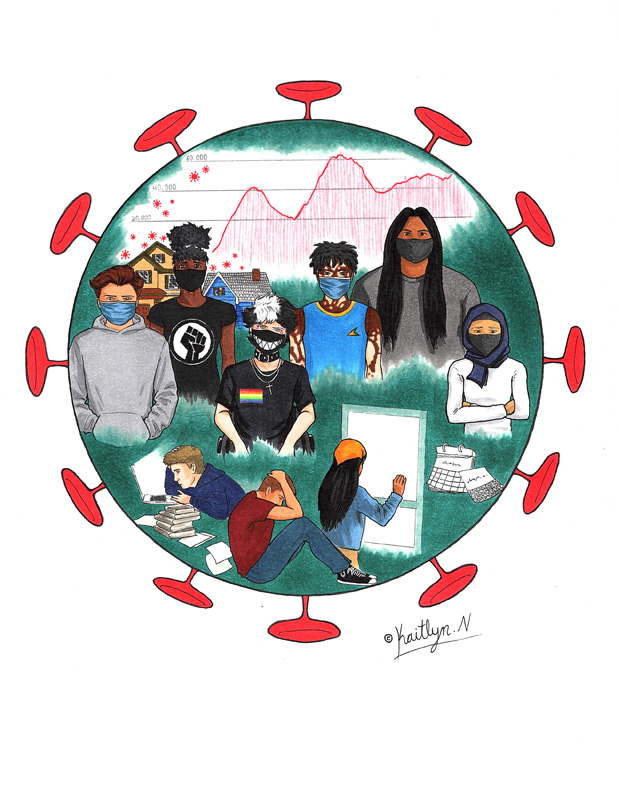
I drew a shape of a coronavirus, which is the main idea of the piece. It represents COVID-19, and how youth were affected by it. Inside the shape are young people, from many different backgrounds and identities, and the tolls that this pandemic had taken on them. I gained inspiration for this piece through how I was feeling during the pandemic, and I have not really done any art piece tying to the current state of the world, or a piece that represents a real issue before, so this priority area became the perfect opportunity.
Introduction
As barriers continue to rise, career aspirations dwindle and student debt increases, there is a pressing need to address the variety of challenges youth are facing in finding employment. While COVID-19 exacerbated many of these challenges, it also presented youth with more free time, which led to a rise in entrepreneurship. Youth are asking governments for help in growing their networks, finding entry-level opportunities, addressing their student debt and ensuring equitable opportunities for all.
Barriers to employment
Youth face many barriers that hinder their access to employment such as a lack of access to technology, professional networks and career development opportunities. Youth that come from low-income or marginalized communities are disproportionately impacted by these barriers. It is also problematic for youth who cannot find work in their official language of choice due to a lack of appropriate employment opportunities.
“If you do not have a strong network its harder to have access to certain opportunities.”
Career aspirations
Youth expressed a need for stability, work-life balance and relevant work experiences. However, given how challenging it is to find an entry-level job, youth are not able to envision their potential career options.
“If I wanted more of a casual job, I could probably get one. A career seems to be a whole different type of situation, just because I don’t actually have any college, job, or university experience.”
Youth are choosing to delay graduation or pursue further schooling due to the increased stress of not being able to find employment.
COVID-19
Due to COVID-19, job opportunities have become scarce and more competitive. As a result, youth expressed that they feel demotivated and stressed. In addition, the lack of social interaction is taking a mental toll on individuals.
“Remote work removes the social outlet that many people used to have, and has taken a toll on people who have little social interaction.”
As for positive impacts, the lack of employment opportunities led to an increase in entrepreneurship. Many youth found the motivation and capacity to start their own companies and initiatives.
“I was looking for a job with young people right ahead of COVID-19. The opportunities were all cancelled – but I was able to build my company because of it.”
Financial concerns
Youth are struggling to pay the bills. The cost of post-secondary education continues to rise and entry-level salaries are not enough for youth to pay off their student loans. This financial stress takes a toll on youth and can make it difficult for them to excel in school.
“The cost of post-secondary education compared to the wage received for those jobs is not aligned. My generation spent >$50,000 on post-secondary education with the promise of well-paying jobs. This is not the case and sets youth back in their ability to earn money, afford housing and take care of themselves financially.”
Youth are missing out on career development opportunities that are volunteer and/or unpaid.
“A lot of the job building opportunities aren’t paid, which prevents a lot of people from succeeding in their field.”
Equity
There are a disproportionate number of youth with disabilities who are unemployed. These youth are worried that a potential employer would not consider them as a viable candidate because they might be considered “expensive”.
“Will employers see me as expensive in terms of my disability?”
Youth from low-income communities aren’t able to build a strong network of professional connections which ultimately hampers their job opportunities. In addition, discrimination in the workplace leads to pay gaps and unequal opportunities.
“Incomes and salaries are not spread equally or evenly across populations with equal qualifications.”
If youth are interested in exploring government programs related to Employment, below are some examples:
- The Youth Employment and Skills Strategy (YESS) supports young people to develop skills and gain paid work experience to transition into the job market. Visit Youth Employment and Skills Strategy to learn more.
- Futurpreneur is a national, not-for-profit organization that provides financing and support to aspiring business owners aged 18-39. Visit Futurpreneur to learn more.
- The Youth Digital Gateway Beta Release launch in summer 2021 offers youth a digital channel for Government of Canada programs and resources related to employment, skills development, learning and service. Visit Youth Digital Gateway to learn more.
Employment recommendations
Governments must...
- Barriers to employment
- Provide support for programs that help students grow their network, develop core 21st century skills (communication, technical knowledge, creativity) and gain meaningful work experience.
- Incentivize post-secondary institutions to increase the number of co-op/internship opportunities offered to students.
- Career aspirations
- Support programming that exposes youth to a variety of careers and helps youth understand how the skills they learn in school/extra-curriculars/part-time jobs are transferrable to different careers.
- COVID-19
- Create and/or support programming targeted at youth who have lost their jobs as a result of COVID-19.
- Provide more support for entrepreneurial programs that help youth create a solution to a problem they identify in their community.
- Financial concerns
- Reduce tuition fees and/or expand federal grants and scholarships to make post-secondary schooling more affordable.
- Enact legislation to make unpaid internships/practicums illegal as they are not accessible for low-income students.
- Enforce regulations that prevent precarious youth employment and underemployment (i.e. contract work with no benefits).
- Implement a job guarantee for post-secondary students – instead of accessing EI, graduates should be paid to volunteer in their community and/or start their own initiative.
- Equity
- Provide more paid internships and practicums targeted at low-income and marginalized students.
- Expand on regulations that prevent discrimination and harassment in the workplace.
- Investigate unemployment rates and the average salaries of youth across Canada by race, gender and disability.
Conclusion
Youth are facing a variety of challenges finding meaningful employment and there are significant inequities across different groups. Youth need continuous support from governments to attain entry-level jobs that provide opportunities for growth and career development.
Youth need help building their professional networks, finding internships, developing 21st century skills and managing their finances. Governments should support programming that will help youth in these core areas, encourage entrepreneurship and identify the inequities in employment outcomes across different groups.
Innovation, skills and learning

My illustration for "Innovation, Skills and Learning" is focused on the idea of collectivity and connectivity between the three aspects. It is about how we use our skills to push ourselves forward and how all of these skills speak to each other to work together. Ideas do not just happen on their own, everything is influenced by something else and it's that connectivity that blossoms innovation.
Introduction
There are five main themes that surface on the topic of innovation, skills and learning: technology, education, equity, mental health, and skills. There are both positive and negative aspects to many of the factors examined. Each produces a recommendation to help youth have access to better resources and to learn in more stable environments.
Technology
Accessibility and the possibility of different educational settings via online engagement are important to youth. As it pertains to accessibility, the positives include not having to constantly move locations to meet other people or to take advantage of services, which uses more energy and resources. However, on the negative end of the spectrum, internet speed and the price of services can hinder work especially in rural and remote communities. When working from home, technology access and home environments could pose daunting hurdles. But on a more positive note, there could be a sense of greater autonomy and less social anxiety.
“I believe I have become more independent as a student.”
Education
Education is a big part of life for youth in Canada. Post-secondary education can give access to better income later in life. However, education is expensive and many youth leave school still feeling the need to be better prepared for the workforce; youth are seeking unique opportunities to learn more about who they are as individuals and ways to apply their unique interests or skillsets. Students who are active outside of school via community development initiatives and entrepreneurial pursuits have a harder time graduating within 4 years, or completing their education entirely. Students with disabilities often graduate later than their peers as well. For those who wish to study in French, access to francophone schools in official-language minority communities is more difficult and there are disparities between French and English programs. Programs like MitacsFootnote 29 create pathways for post-secondary students to explore entrepreneurship and innovation, however, these are limited in impact because of scope. Undergraduate students from underrepresented communities want to have similar opportunities to gain hands-on experiences in entrepreneurship and innovation.
“I go to school for career opportunities, I work to pay tuition, my household and diet are limited by what I can afford.”
Equity
Access and quality of education is dependent upon location and wealth. Indigenous youth in particular have low rates of completing post-secondary education as a result of relevant ways of knowing and learning, transportation, and other support systems. Youth want to provide solutions to the problems our society faces today and we want to be a part of leading the change. Youth-led organizations must be seen as an asset and not a liability, they want an opportunity to contribute to “building back better” and they are seeking to be valued as part of the structural change needed to achieve equity.
“Disability is a huge and often overlooked source of disparity in education.”
Finally, while COVID-19 has, in some ways, made education more accessible it has also made learning more difficult in other ways.
Mental health
Mental health has been greatly impacted by COVID-19 and education. COVID-19 has caused heavier workloads, and has not allowed for the prioritization of learning the skills necessary for a smooth adjustment to virtual learning. There have necessarily been fewer opportunities for social interactions, making it harder to make friends and nurture strong relationships. Some youth have been isolated with toxic family environments since they are no longer spending time at school. On the other hand, the pandemic has allowed some individuals to learn time management and self-discipline.
Schools should prioritize mental health as the pressure to succeed and take the “right” courses are felt very strongly by many youth. Some youth report feeling pressured to attend postsecondary because society wants them to, despite not having a genuine interest. Having mental health issues distracts from the ability to develop the learning outcomes youth need to advance.
“Spending every hour of the day within the same walls has been soul crushing.”
Skills
The development of skills has been one positive aspect of the pandemic. More free time has, in some cases, led to periods of reflection and self-care. In addition, people delved into entrepreneurial opportunities. A lot of skill building opportunities are made available for university students; however, COVID-19 has highlighted the importance of skill-building outside of educational institutions and into community groups that youth are active participants of.
“During this time, I was able to start up my own small business.”
If youth are interested in exploring government programs related to Innovation, Skills and Learning, below are some examples:
- CanCode helps youth access the digital economy by learning broad digital skills, including coding. The program works to reach young people underrepresented in science, technology, engineering, and mathematics (STEM), such as girls and Indigenous Peoples. Visit CanCode to learn more.
- The Student Work Placement Program (SWPP) provides post-secondary students across Canada with relevant paid work experience. Visit Student Work Placement Program to learn more.
Innovation, skills and learning recommendations
Governments must...
- Technology
- Provide subsidies for youth and students who are working from home, or in more rural/remote areas in order to support greater access to affordable technology and internet.
- Support financial and infrastructure investments in rural/remote areas to enhance connectivity.
- Education
- Increase youth investment for social-enterprise, entrepreneurship and innovation fellowships (especially targeting underrepresented communities).
- Increase investment in work-integrated learning opportunities for students in high school and post-secondary education.
- Equity
- Increase investments and capacity building initiatives for youth-led organizations.
- Skills
- Develop a national skill-building strategy; one that allows youth to provide input into the types of skills they want to develop and the kinds of learning experiences that they value.
Conclusion
While it is clear that youth are facing many challenges, determination has been seen in the many positive points throughout the subtopics of innovation, skills, and learning. If the recommendations listed are followed, youth will have a better platform from which to exercise perseverance. All youth should be given equal and fair opportunities to learn and succeed. Extra or unnecessary hardships only serve to slow and harm their development and goal achievement.
Conclusion
Active listening and next steps
Through this State of Youth Report, youth in Canada have spoken, sharing not only their realities in 2021, but also calling for action with 28 recommendations. Governments at all levels and other youth-supporting groups are strongly encouraged to consider the evidence contained in this Report. The Government of Canada acknowledges these recommendations.
Further, throughout its ongoing dialogue with youth, which has led to this first State of Youth Report, it has heard youth consistently calling for:
- More relevant and timely youth-focused data;
- Sustained, accessible youth engagement, and
- More than anything, action on issues of utmost importance to youth.
The time for action is now.
Youth data: There are plans to address limitations in youth data. Proposed investments in Budget 2021, including the implementation of a Disaggregated Data Action Plan by Statistics Canada, will help paint a fuller picture of youth in Canada. Further, to improve statistics on LGBTQ2 communities in Canada, Statistics Canada has updated the standard on gender of person in Census 2021, and is also working to propose new standards for sexual orientation for future national data collection purposes.
Statistics Canada also supports the Youth Secretariat at Canadian Heritage in its engagement with youth. To complement this work, Statistics Canada is developing a new publication that highlights recent data on Canadian youth. The first chapter of Statistics Canada’s Portrait of Youth in Canada on the Health of Youth in Canada was published in February 2021. Additional chapters being published are focused on themes such as demographics, employment, education, social engagement and well-being, the environment, and Indigenous youth.
Excellence in youth engagement: The national dialogue that began with the creation of a Prime Minister’s Youth Council (2016) and the development of Canada’s first Youth Policy (2019) has charted a commitment to excellence in youth engagement. This Report is but one milestone. And while the Policy commits to a similar report every four years, youth today have consistently expressed they do not wish to wait that long to speak with government again on issues that matter to them, nor for their views to remain static in a PDF document or webpage. As such, the Youth Advisory Group is collaborating on solutions to explore a variety of online, social media and interactive formats.
One key objective is to move towards continuous engagement through an online platform that is accessible, inclusive and interactive. This resource should reach youth where they are, and connect decision makers with diverse youth across Canada, to best inform future directions in youth programming and initiatives.
Federal action for youth: Youth are challenging leadership everywhere towards continuous improvement. For the Government of Canada this means increased responsiveness, cohesion and transparency on federal youth initiatives.
“Young people made it clear that a federal youth policy should lead to action.”
Youth priorities are diverse and far reaching. This Report has shared a small sample of key initiatives available today, but increased supports and broader awareness and access to existing programs are crucial.
The Federal Youth Secretariat exists to help amplify youth voices to affect positive change, and ensure youth perspectives are taken into consideration in government policy and decisions. It is poised to lead a plan for collaborative action and accountability, rooted in the issues raised by youth in Canada today.
Gratitude
The Federal Youth Secretariat would like to thank the youth who rose to the call and spoke truth to power. Through your candour and willingness to be vulnerable, we were able to see the world through a different lens. Youth recommendations, insight, and engagement throughout this process will benefit the government in the years to come. They have undoubtedly shown that youth in Canada are hopeful we can build a consciously more inclusive country.
“We don’t want a seat at the table; we want to widen the table altogether!!”
Annex A: Glossary of terms
Language matters. Youth have used language throughout this process to share their perspectives and express how they wish to be seen and understood. To further uphold the voices of young people and to help guide the reader, a glossary has been included below to define some of the terms found throughout the State of Youth Report.
This glossary was compiled with the aim of including and respecting various types of knowledge. In some instances, definitions have been listed with citations from government sources, scholarly literature, or news media. In other cases, youth defined the terms they identified throughout the State of Youth Report, using their own words to capture their meaning. This distinction is made throughout the endnotes provided.
- Allyship:
- Active, consistent, and arduous practice of unlearning and re-evaluating, in which a person of privilege seeks to operate in solidarity with a marginalized group of people. Allyship is not an identity—it is a lifelong process of building relationships based on trust, consistency, and accountability with marginalized individuals and/or groups of people. Allyship is not self-defined—our work and our efforts must be recognized by those with whom we seek to ally ourselvesFootnote 30. Those who practice allyship may be recognized and referred to as “allies”, with the singular form “ally”.
- Decolonization:
- Decolonization is the process by which Indigenous Peoples refute historical and current colonialist stories about themselves, and reclaim their languages, cultures, knowledge systems, political and social worldviews. Decolonization is about attempts to reverse the damage inflicted upon Indigenous Peoples through the educational, health, social, justice and political systems. While colonization is about the colonizer imposing its worldview on the original inhabitants, decolonization is about the colonizer growing its respect for the original inhabitants' worldviews. Decolonization begins at the individual level—decolonization of the mind. In many cases, it will be a lifelong process. Decolonization means reclaiming Indigenous identity, roles and responsibilities, traditional family and community structure and leadership, traditional governance systems and cultures. Decolonization means reclaiming the sacred connection to the landFootnote 31.
- Defunding:
- In the context of defunding the police, this refers to reallocating or redirecting funding away from police departments to other government agencies funded by local municipalitiesFootnote 32. Almost all police services in Canada ascribe to a community policing model, which focuses on building public trust and meeting a community’s needs over forceful crime control. Those calling for defunding question the effectiveness of this approach, and seek to redistribute a portion of police funds toward social services better equipped to serve the needs of communitiesFootnote 33.
- Digital carbon footprint:
- A carbon footprint that is produced from the use of technology (for example, using a laptop)Footnote 34.
- Equity:
- Equity (also known as social equity) is defined as “the state, quality or ideal of being just, impartial and fair.” It is synonymous with fairness and justice, and should be considered as a structural and systemic concept. Equity involves trying to understand and give people what they need to enjoy full, healthy lives. Equality, by contrast, aims to ensure that people receive identical things to enjoy full, healthy lives. Equity involves a complex combination of related elements which create and support social justice, and is a dynamic process which replicates equitable ideas, power, resources, strategies, conditions, habits, and outcomes at the systemic levelFootnote 35. It recognizes that treating people the same can lead to unequal results, and that treating people in an equitable way, accounting for individual needs, will achieve the desired results of equality. Equality is sometimes used interchangeably with equity; however, equity is a more flexible measure that allows for equivalency while not demanding samenessFootnote 36.
- Grounded theory:
- Grounded theory is used in qualitative research and differs from the traditional approach where information is collected to test a potential explanation or assumption. Instead, grounded theory emphasizes starting from the ground up (i.e. generating theory from data) rather than from the top down (i.e. using data to test theory). It favours an inductive approach, rather than a deductive oneFootnote 37.
- Indigenization:
- Indigenization is a term that may be used in a variety of ways depending on the context. For the purposes of this document, Indigenization (with a capital “I”) means change led by Indigenous Peoples to bring Indigenous ways of knowing, being and doing into spaces that are not designed for those waysFootnote 38. It is important to note that Indigenization is not synonymous with decolonization or uncolonization, as it does not necessarily demand detachment or rejection of colonial systems, and Indigenized systems may exist within colonial systems themselvesFootnote 39.
- Institutionalization:
- A process by which people are physically separated from their communities and/or families and placed in institutions. These institutions include, but are not limited to: punitive carceral institutions, educational institutions, group homes, etc. The terms “institution” and “institutionalization” refer to inequalities, including social inequalities, oppression and marginalized identities, ableism, racism and classism. In turn, these institutions uphold ableism, racism and classism in their varying types and forms of institutionalization.
- LGBTQ2:
- Lesbian, Gay, Bisexual, Transgender, Queer, Two-Spirit. This is the acronym used by the Government of Canada to refer to the Canadian community. LGBTQ2 terminology is continuously evolving. As a result, it is important to note that this list is not exhaustive and these definitions are a starting point to understanding LGBTQ2 identities and issues. Different LGBTQ2 individuals and communities may have broader or more specific understandings of these termsFootnote 40. Note: detailed definitions for each term listed (and others not included here) can be found on the Government of Canada website cited below.
- Person(s)/People of Colour (POC):
- A term used to refer to non-white people, instead of the term “visible minority,” which implies inferiority and disenfranchisement. The term (not to be confused with the pejorative “colored people”) emphasizes common experiences of racial discrimination and racism,Footnote 41 and is used as an inclusive frame across non-white racial groups to address racial inequitiesFootnote 42. Note that the term “people of colour” is a political/social identity, and cannot be considered synonymous with individual racial groups (i.e. “people of colour” is not interchangeable with “Black people”, but a Black person may consider themselves a person of colour)Footnote 43. Within the Canadian context, Indigenous Peoples—though sharing common experiences of racial discrimination and racism—may be acknowledged separately from people of colour in order to recognize their distinct status under the Canadian ConstitutionFootnote 44.
- Queer:
- Historically a derogatory term used as a slur against LGBTQ2 people, this term has been reclaimed by many LGBTQ2 people as a positive way to describe themselves, and as a way to include the many diverse identities not covered by common LGBTQ2 acronymsFootnote 45.
- Racialized:
- The process through which groups come to be designated as different, and on that basis, subjected to unequal treatment. Racialized groups include people who might experience differential treatment on the basis of race, ethnicity, language, religion or culture. Racialized groups are treated outside the norm and receive unequal treatment based on their race. Racialization can extend to specific traits and attributes, which are connected to racialized people and deemed to be abnormal and of less worth. Besides physical characteristics of people, other characteristics that are commonly racialized are accent, speech, name, clothing, diet, intelligence, beliefs, practices and habitsFootnote 46.
- Residential schools for youth with disabilities:
- These are boarding schools dedicated to education for children and youth with disabilitiesFootnote 47. They provide full-time support for students through residential programming, academic accommodations and recreational activities. Students live in-residence at these schools, typically from Sunday until Friday during the school year. These schools have their own internal inequalities, cultures and purpose.
- Sustainability:
- The pursuit of supporting needs today while preserving the future’s ability to provide for those needsFootnote 48.
- Two-Spirit:
- (also Two Spirit or Two-Spirited). An English term used to broadly capture concepts traditional to many Indigenous cultures. It is a culturally-specific identity used by some Indigenous Peoples to indicate a person whose gender identity, spiritual identity and/or sexual orientation comprises both male and female spiritsFootnote 49.
- Uncolonization:
- As “decolonization” may be a process specific to Indigenous Peoples—and not reserved for settlers who benefit from the ongoing oppression of Indigenous Peoples—“uncolonization” is a term that may be used by settlers to refer to their own processes of detaching and disconnecting from colonial systems, practices, and vestigesFootnote 50.
- Youth:
- Youth tends to be a fluid age category, and is defined as the stages between adolescence to early adulthood, often culturally seen as a transition from dependence toward independence and autonomyFootnote 51. The Government of Canada refers to several age brackets for youth depending on the context and/or the programs and policies in question. For example, Statistics Canada defines youth as between 15-29 years of age, whereas Canada’s Youth Policy and the first State of Youth Report engaged youth between the ages of 12-30, as well as anyone outside of this bracket who self-identified as “youth” (which resulted in participants from 13-36 in age). By comparison, the United Nations more rigidly defines youth as persons between the ages of 15 and 24 years, for statistical purposesFootnote 52.
- Youth Homelessness:
- As described by the Canadian Observatory on Homelessness (via the Homeless Hub) this is referred to as “the situation and experience of young people between the ages of 13 and 24, who are living independently of parents and/or caregivers, but do not have the means or ability to acquire a stable, safe or consistent residence.”Footnote 53.
Annex B: Spotlight on engagement data
This annex highlights Statistics Canada data (and in one case Environics Institute data) shared with youth to stimulate discussion as part of the SOYR engagement sessions, and youth responses. In what follows, two types of data are juxtaposed, for each of the six priority areas:
- Data shared with youth in SOYR engagement sessions (quantitative, in the form of bar charts and graphs)
- Youth response to this numerical data, in the form of Word Clouds based on the narratives in the youth engagement sessions (qualitative, highlight word frequency using font size).
While certain synergies exist, in some cases, discrepancies are revealed between government statistics and youth responses.
Quantitative data was developed in collaboration with Statistics Canada to stimulate discussion during SOYR engagement process. Youth responded to these quantitative data in a variety of ways, highlighting the diversity of perspectives among youth in Canada. Overall, three general trends were apparent in their responses: youth responded to the language used in the data, which at times did not reflect the language they prefer to use to describe themselves or their circumstances, they responded to the data’s areas of focus, which were generally felt to not be sufficiently holistic, and they responded to the “age” of the data, which in many cases did not feel recent enough. Primary data from Canada’s First State of Youth Report engagement sessions and the individual response forms can be found on the Government of Canada’s Open Government Portal by searching the term Canada’s First State of Youth Report.
Statistics Canada is responsive to these views of youth, and most recently has engaged with youth in the 2019 Prime Minister’s Youth Summit to identify priority topics and ways by which youth would prefer to consume quantitative statistical information. This engagement led to a joint dissemination product, an infographic entitled, “What matters to Canadian Youth?”, released July 2019.
It is worth noting that while up-to-the-minute statistics are desired by youth, producing high quality, reliable data requires time. For more information on the data process, please see this link: The Data Journey: What you need to know for successful navigation (statcan.gc.ca).
Priority area: Truth and reconciliation
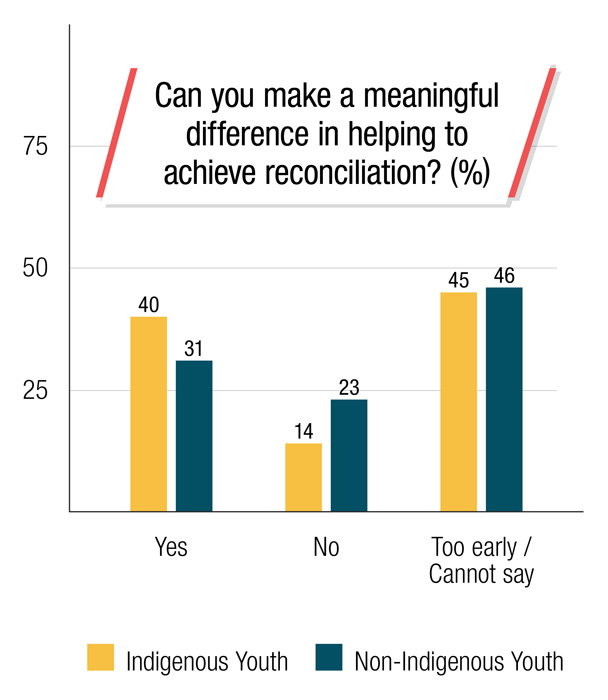
Source: Environics Institute’s Canadian Youth Reconciliation Barometer (2019)
Figure 2. Can you make a meaningful difference in helping achieve reconciliation - text version
| Yes | No | Too early/Cannot say | |
|---|---|---|---|
| Indigenous | 40 | 14 | 45 |
| Non-Indigenous | 31 | 23 | 46 |
Figure 2 shows data from Environics Institute’s Canadian Youth Reconciliation Barometer, which asked Indigenous youth and non-Indigenous youth whether they believed they could make a meaningful difference in helping to achieve reconciliation, with Indigenous youth indicating greater optimism that they could.
What can be observed in Figure 3 reflects that youth’s conversation referred to action, in much the same way as the data in Figure 2, with words like “want,” “know, “make,” and “work”, and their focus on “culture,” “education” and “community” perspective. These data come from a mix of Indigenous and non-Indigenous respondents.
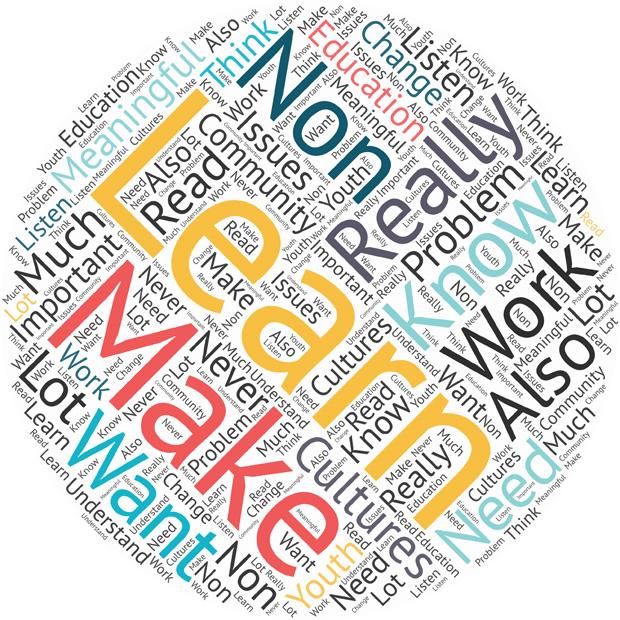
Figure 3. Whose Responsibility is Truth and Reconciliation? - text version
| Word | Frequency |
|---|---|
| learn | 11 |
| really | 11 |
| know | 9 |
| make | 8 |
| non | 8 |
| want | 8 |
| work | 8 |
| cultures | 7 |
| education | 6 |
| community | 5 |
| meaningful | 5 |
| need | 5 |
| also | 4 |
| change | 4 |
| important | 4 |
| issues | 4 |
| listen | 4 |
| lot | 4 |
| much | 4 |
| never | 4 |
| problem | 4 |
| read | 4 |
| think | 4 |
| understand | 4 |
| youth | 4 |
Priority area: Environment and climate action
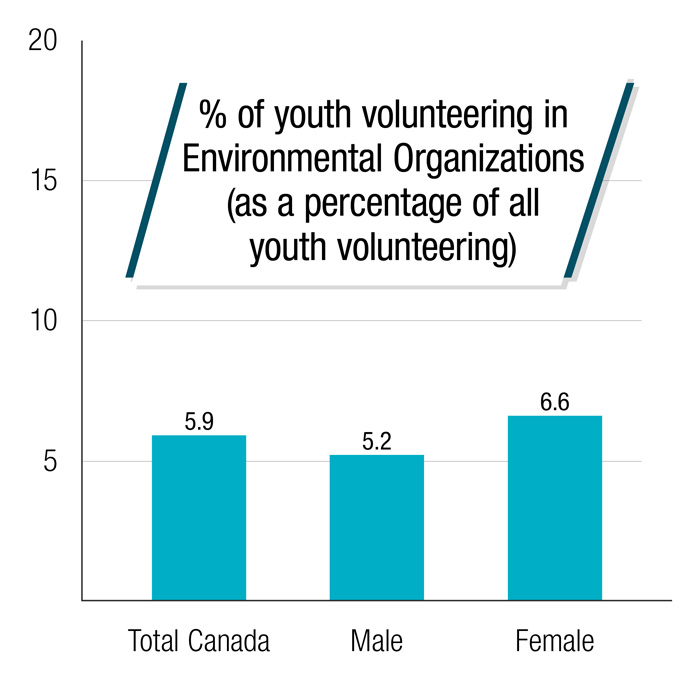
Source: Statistics Canada Census 2016
Figure 4. Percent of Youth Volunteering in Environmental Organizations – text version
| Indicator | Total Canada | Male | Female |
|---|---|---|---|
| Percentage of youth volunteering in Environmental Organizations (as a percent of all youth volunteering) | 5.9% | 5.2% | 6.6% |
The Census 2016 data, shown in Figure 4, focused on volunteerism in environmental organizations and was shared with youth as part of the State of Youth Report engagement sessions.
Figure 5 represents youth response to this numerical data and the word frequencies in the wider conversation around environment and climate action.
“Environment” and “climate” were unsurprisingly found amongst the most frequently used words in that priority area, along with: “Youth,” “making,” “change,” “community” and “impact”. This indicates conversations focused on action: making change.
The conversations specifically naming the theme of “volunteerism” had much less focus, but the need for action, change and impact was explicit and clear.
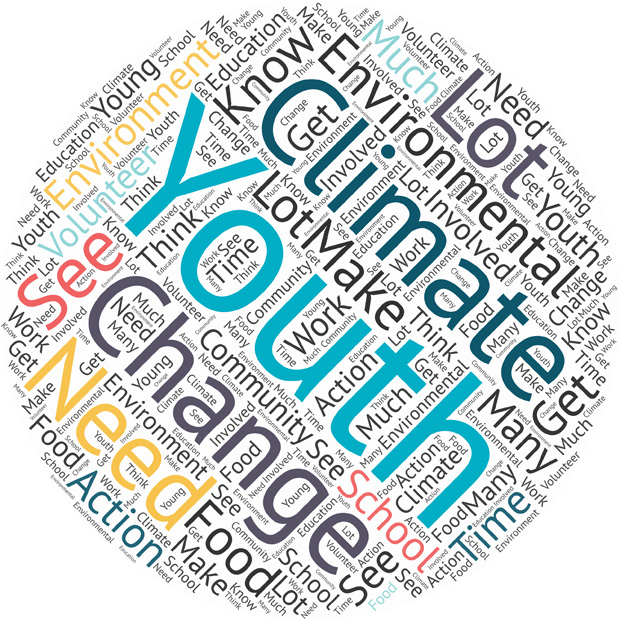
Figure 5. Environment and Climate Action Overall Themes – text version
| Word | Frequency |
|---|---|
| youth | 50 |
| climate | 44 |
| change | 33 |
| environment | 32 |
| environmental | 24 |
| need | 20 |
| see | 20 |
| lot | 19 |
| make | 16 |
| action | 15 |
| food | 15 |
| many | 15 |
| school | 15 |
| know | 14 |
| time | 14 |
| community | 13 |
| get | 13 |
| involved | 13 |
| much | 12 |
| volunteer | 12 |
| young | 12 |
| education | 11 |
| think | 11 |
| work | 11 |
Priority area: Health and wellness
Figure 6 on Health Status, Access to Healthcare and Life Satisfaction (%) was shared with youth as part of the State of Youth Report engagement sessions.
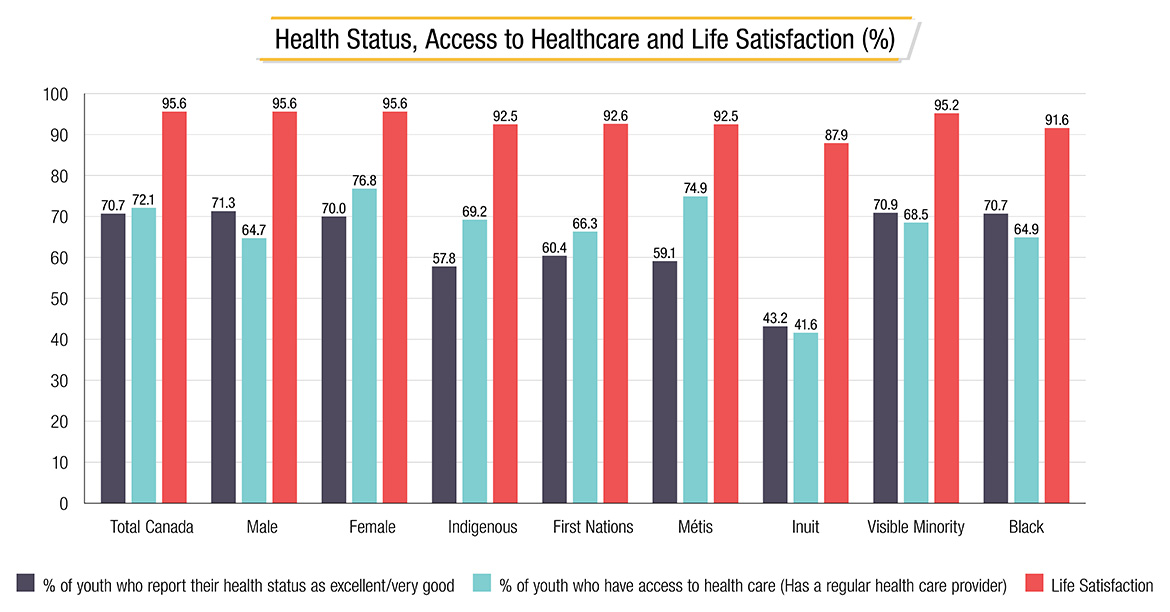
Sources: Canadian Community Health Survey, 2017-2018, UNICEF - Index of Child & Youth Well-Being (2019)
Figure 6. Health Status, Access to Healthcare and Life Satisfaction - text version
| Indicator | Total Canada | Male | Female | Indigenous | First Nations | Métis | Inuits | Visible Minority | Black |
|---|---|---|---|---|---|---|---|---|---|
| % of youth who report their health status as excellent/very good | 70.70% | 71.30% | 70.00% | 57.80% | 60.4% | 59.1% | 43.2% | 70.90% | 70.70% |
| % of youth who have access to healthcare | 72.1% | 64.7% | 76.8% | 69.2% | 66.3% | 74.9% | 41.6% | 68.5% | 64.9% |
| Life Satisfaction | 95.6% | 95.6% | 95.6% | 92.5% | 92.6% | 92.5% | 87.9% | 95.2% | 91.6% |
Figure 7 shows which words were most used by youth at engagement sessions on Health and Wellness. Figure 8 shows the frequency of words that were communicated by youth in the context of mental health. In their conversations, youth highlighted the importance of community and support in healthcare needs, including school, physical health and services. The Statistics Canada data – which greatly pre-date the COVID-19 pandemic – generally show excellent or good health status and good access to health care. However, during SOYR engagement sessions at the height of the pandemic, youth were more focused on issues related to mental health and access to support, as well as the gaps and challenges COVID-19 has created and exacerbated for youth across Canada in a variety of areas.
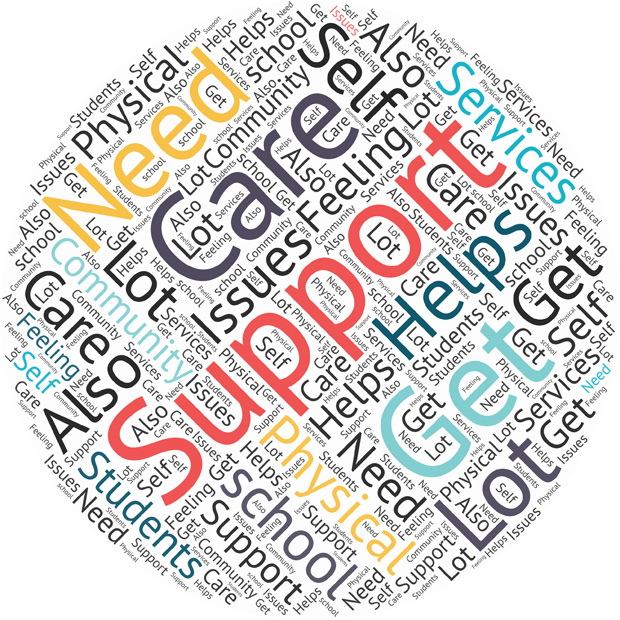
Figure 7. Health and Wellness Overall Theme – text version
| Word | Frequency |
|---|---|
| mental | 77 |
| care | 61 |
| get | 59 |
| need | 58 |
| physical | 55 |
| community | 46 |
| services | 44 |
| times | 43 |
| school | 42 |
| lot | 38 |
| also | 35 |
| feeling | 35 |
| issues | 35 |
| self | 35 |
| students | 35 |
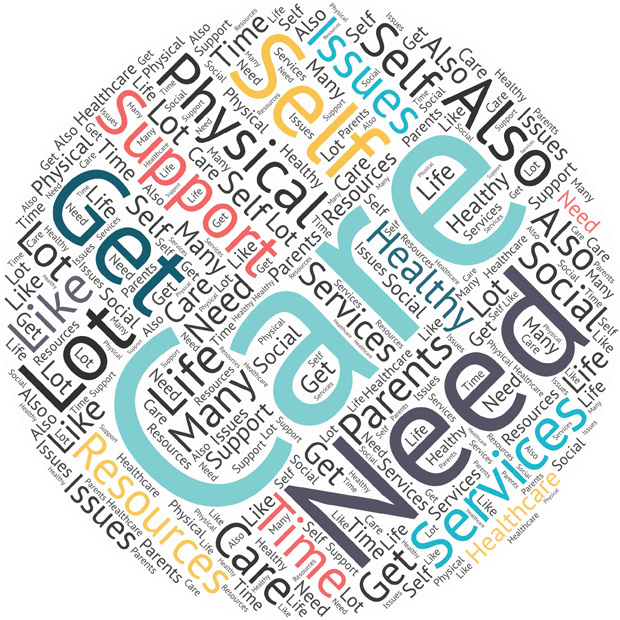
Figure 8. Mental Health Theme – text version
| Word | Frequency |
|---|---|
| care | 28 |
| support | 23 |
| physical | 23 |
| need | 18 |
| self | 17 |
| get | 17 |
| services | 16 |
| also | 16 |
| lot | 15 |
| resources | 14 |
| issues | 14 |
| many | 12 |
| like | 11 |
| healthy | 11 |
| time | 10 |
| social | 10 |
| parents | 10 |
| life | 10 |
| healthcare | 10 |
Priority area: Leadership and impact
Figure 9 and Figure 10 on Political Activity of Canadian Youth and Youth Feelings of Confidence in Public Institutions respectively with data from Statistics Canada were shared with youth participants.
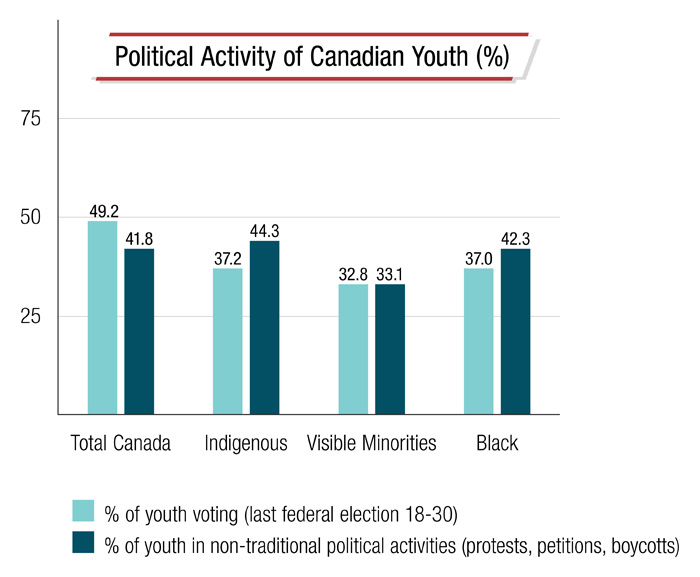
Source: General Social Survey, Social Identity 2013. Samara - You have our attention (2019)
Figure 9. Political Activity of Canadian Youth - text version
| Political Activity of Canadian Youth | Total Canada | Indigenous | Visible Minority | Black |
|---|---|---|---|---|
| #, % of youth voting (last federal election 18-30) | 49.2% | 37.2% | 32.8% | 37.0% |
| Youth in non-traditional political activities (protests, petitions, boycotts) | 41.8% | 44.3% | 33.1% | 42.3% |
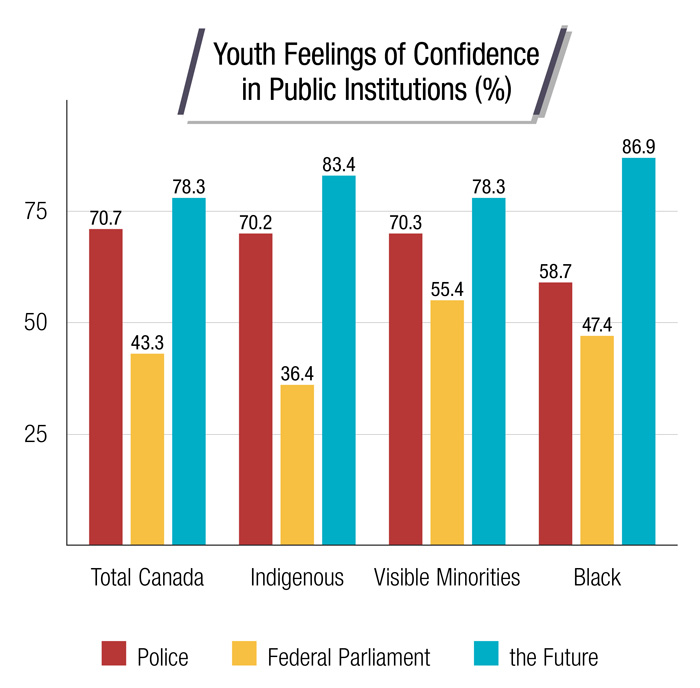
Source: General Social Survey, Social Identity 2013. Samara - You have our attention (2019)
Figure 10. Youth Feelings of Confidence in Public Institutions – text version
| Indicator | Total Canada | Indigenous | Visible Minority | Black |
|---|---|---|---|---|
| Police | 70.7% | 70.2% | 70.3% | 58.7% |
| Federal Parliament | 43.3% | 36.4% | 55.4% | 47.4% |
| The Future | 78.3% | 83.4% | 78.3% | 86.9% |
Although Figures 9 and 10 were shared, youth spoke most commonly on other matters. Figure 11 came from the overall conversation around leadership and impact, and youth spoke about the desire to have “opportunities” and “leadership”. Figure 12 illuminates the themes explored by youth when discussing the theme “government”. Although the traditional role of government was heavily discussed, discussion about the police, abuses of power and their potential defunding also emerged, aligning with the Statistics Canada data on levels of trust and mistrust towards that institution.
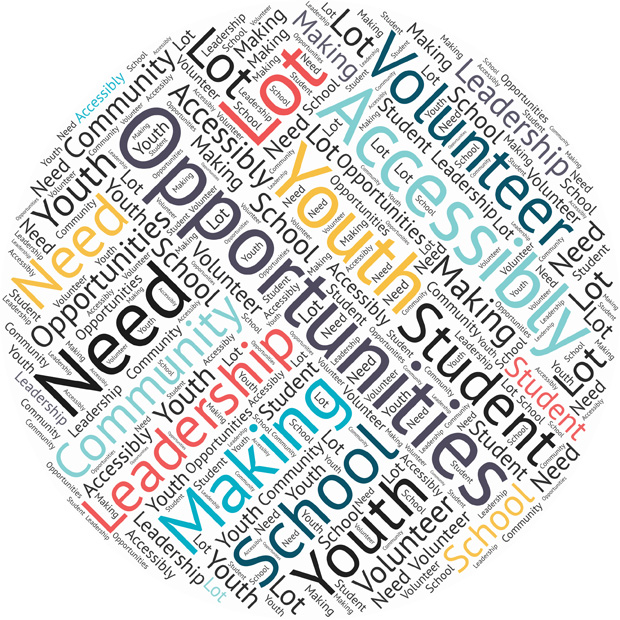
Figure 11. Leadership and Impact Overall Themes – text version
| Word | Frequency |
|---|---|
| opportunities | 483 |
| youth | 469 |
| leadership | 364 |
| the | 294 |
| making | 252 |
| community | 242 |
| accessibly | 214 |
| of | 198 |
| need | 179 |
| volunteer | 172 |
| school | 162 |
| youth | 153 |
| lot | 153 |
| student | 138 |
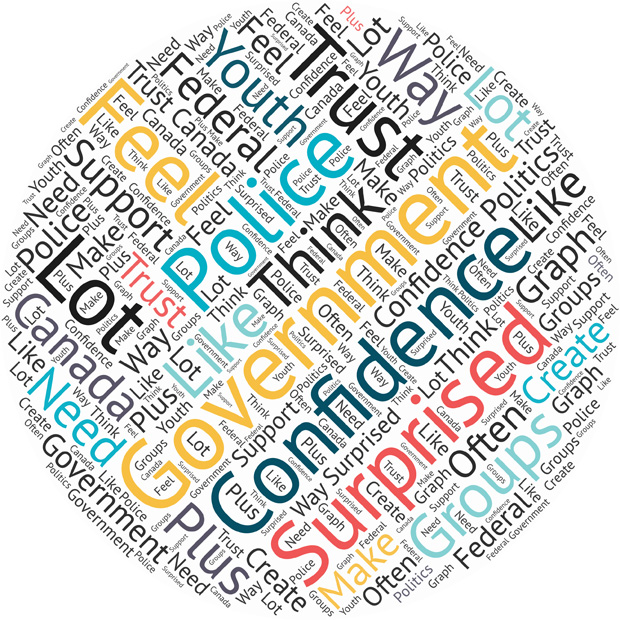
Figure 12. Government Theme – text version
| Word | Frequency |
|---|---|
| government | 29 |
| Police | 26 |
| governments | 10 |
| confidence | 8 |
| lot | 8 |
| surprised | 8 |
| trust | 8 |
| Canada | 7 |
| feel | 7 |
| federal | 6 |
| groups | 6 |
| Like | 6 |
| support | 6 |
| think | 6 |
| way | 6 |
| create | 5 |
| do | 5 |
| graph | 5 |
| youth | 5 |
| make | 5 |
| need | 5 |
| often | 5 |
| plus | 5 |
| politics | 5 |
| provide | 5 |
| really | 5 |
Priority area: Employment
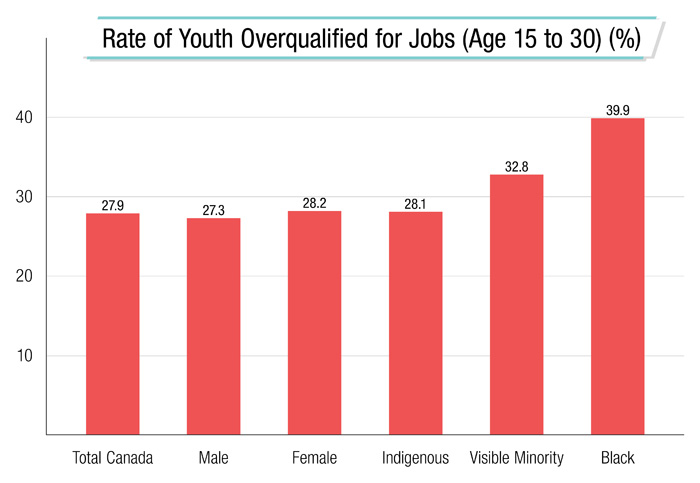
Source: Statistics Canada 2016 Census
Figure 13. Rate of Youth Overqualified for Jobs - text version
| Indicator | Total Canada | Male | Female | Indigenous | Visible Minority | Black |
|---|---|---|---|---|---|---|
| Rate of youth over qualification for jobs (age 15 to 30) | 27.9% | 27.3% | 28.2% | 28.1% | 32.8% | 39.9% |
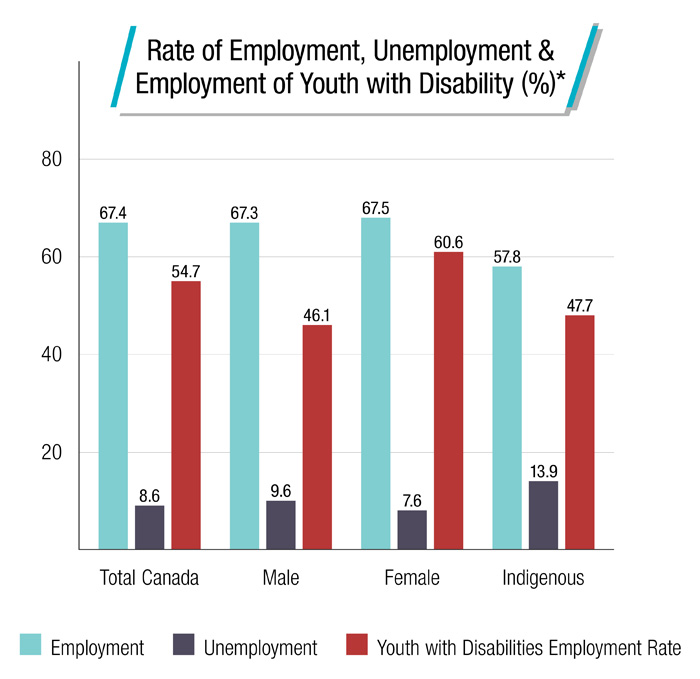
Source: Statistics Canada Labour Force Survey 2019
Figure 14. Rate of Employment, Unemployment & Employment of Youth with Disability – text version
| Indicator | Total Canada | Male | Female | Indigenous | First Nations* |
|---|---|---|---|---|---|
| Youth employment rate (age 15 to 30) | 67.4% | 67.3% | 67.5% | 57.8% | 51.6% |
| Youth unemployment rate (age 15 to 30) | 8.6% | 9.6% | 7.6% | 13.9% | 16.5% |
| Rates of employment, youth with a disability (age 15-30) | 54.7% | 46.1% | 60.6% | 47.7% | 38.7% (42.4%) |
Figure 13 on the rate of youth overqualified for jobs and Figure 14 on the rate of employment, unemployment and employment of youth with disability were shared with youth participating in the employment engagement sessions.
Figure 15 shows the overall comments on employment made by youth during their sessions. Their responses were generally less focused on unemployment and over qualification and more on the basic themes of having and getting a job. Figure 16 shows the barriers to employment were highlighted, where qualification and availability of employment were listed as the main issues, as is seen in the predominance of words such as “experience,” “find” and “get”.

Figure 15. Employment Overall Theme – text version
| Word | Frequency |
|---|---|
| job | 234 |
| working | 88 |
| get | 67 |
| employment | 66 |
| not | 64 |
| experiences | 60 |
| that | 57 |
| It is | 55 |
| for | 51 |
| employment | 50 |
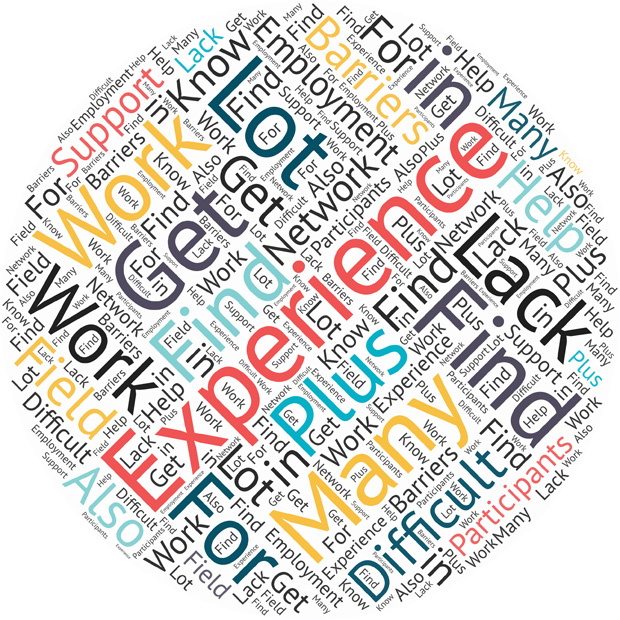
Figure 16. Barriers to Employment – text version
| Word | Frequency |
|---|---|
| get | 31 |
| experience | 31 |
| many | 16 |
| lot | 16 |
| find | 15 |
| It is | 15 |
| employ | 14 |
| work | 13 |
| plus | 13 |
| employment | 13 |
| lack | 12 |
| barriers | 12 |
| pour | 11 |
| difficult | 11 |
| find | 10 |
| help | 9 |
| support | 8 |
| participants | 8 |
| network | 8 |
| know | 8 |
| field | 8 |
| in | 8 |
| also | 8 |
Priority area: Innovation, skills and learning
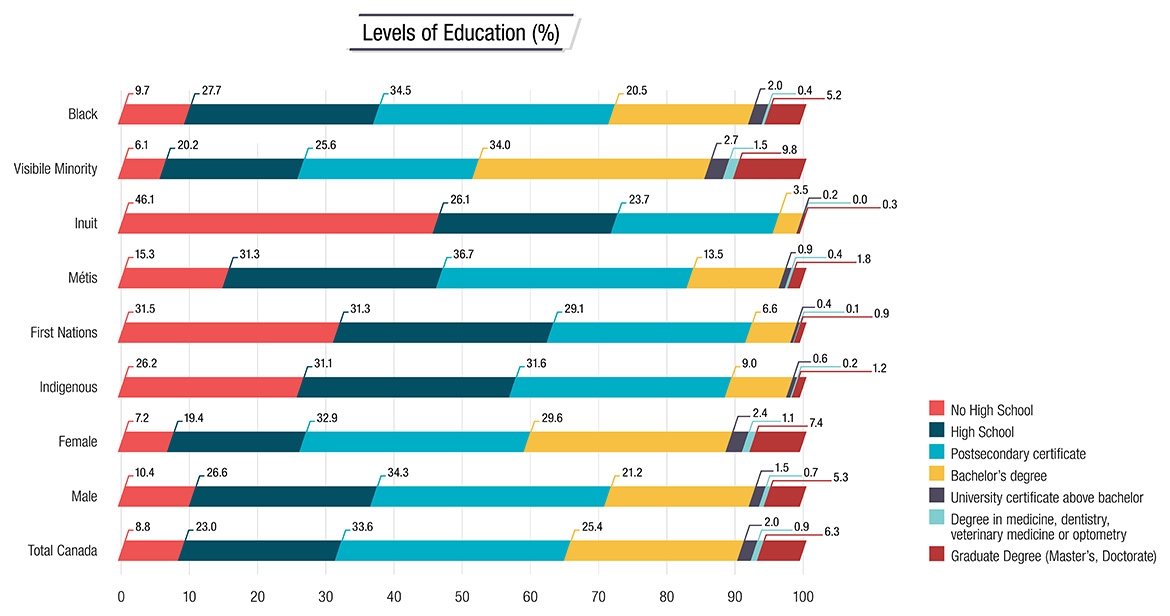
Source: Statistics Canada 2016 Census
Figure 17. Levels of Educational Attainment – text version
| Indicator | Total Canada | Male | Female | Indigenous | First Nations* | Métis | Inuit | Visible Minority | Black |
|---|---|---|---|---|---|---|---|---|---|
| Neither high school nor postsecondary | 8.8% | 10.4% | 7.2% | 26.2% | 31.5% | 15.3% | 46.1% | 6.1% | 9.7% |
| High School (no post-secondary) | 23.0% | 26.6% | 19.4% | 31.1% | 31.3% | 31.3% | 26.1% | 20.2% | 27.7% |
| Postsecondary certificate or diploma below bachelor level | 33.6% | 34.3% | 32.9% | 31.6% | 29.1% | 36.7% | 23.7% | 25.6% | 34.5% |
| Bachelor's degree | 25.4% | 21.2% | 29.6% | 9.0% | 6.6% | 13.5% | 3.5% | 34.0% | 20.5% |
| University certificate or diploma above bachelor level | 2.0% | 1.5% | 2.4% | 0.6% | 0.4% | 0.9% | 0.2% | 2.7% | 2.0% |
| Degree in medicine, dentistry, veterinary medicine or optometry | 0.9% | 0.7% | 1.1% | 0.2% | 0.1% | 0.4% | 0.0% | 1.5% | 0.4% |
| Graduate Degree (Masters, Doctorate) | 6.3% | 5.3% | 7.4% | 1.2% | 0.9% | 1.8% | 0.3% | 9.8% | 5.2% |
The data from Figure 17 from Statistics Canada’s 2016 Census demonstrates differences in the level of educational attainment for a youth from a variety of diverse backgrounds and by sex. It indicates that some groups have lower levels of completion of high school and post-secondary than others. When youth explored the barriers that keep diverse young people from accessing education, their input expands upon the Statistics Canada data, using words that might indicate why some demographic groups may struggle with lower educational attainment. Words such as “areas,” “resources,” “funding, and “income” were used frequently by the youth, as demonstrated in Figure 18.
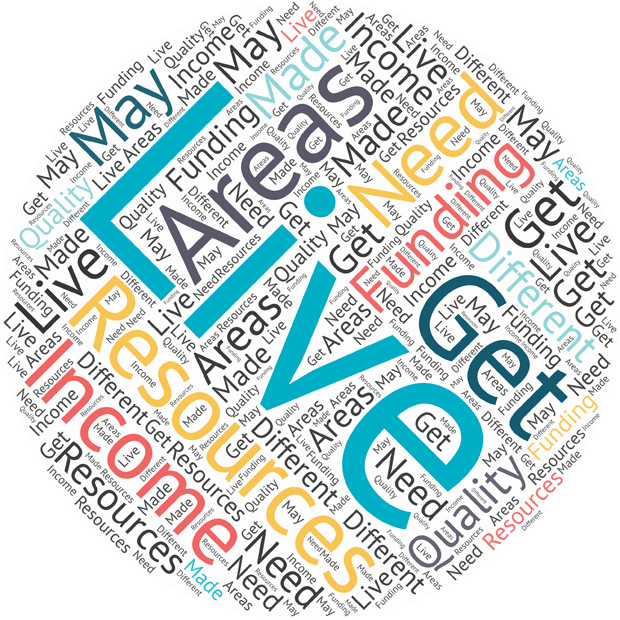
Figure 18. Equity Theme – text version
| Word | Frequency |
|---|---|
| live | 17 |
| areas | 15 |
| resources | 15 |
| funding | 14 |
| get | 14 |
| income | 14 |
| need | 12 |
| different | 11 |
| may | 11 |
| quality | 11 |
| made | 10 |
Annex C: Youth Advisory Group and young artist biographies
Youth Advisory Group (YAG) members
Alex Daigle (She/Her)

Alex Daigle is a queer Franco-Albertan from Edmonton. She graduated from Campus Saint-Jean and currently works with 2S and LGBTQ2 organizations across the country as part of her role as a Francophone Liaison and Program Coordinator with the Enchanté Network. She spends most of her time in nature, listening to historical documentaries, Star Trek and making artistic creation.
Alfred Burgesson (He/Him)

Alfred Burgesson emigrated from Ghana to Canada at a young age. In addition to being a member of the Prime Minister’s Youth Council, he serves on the board for the Halifax Public Library. He is passionate about youth issues, entrepreneurship and community development. Alfred is Executive Director of Tribe Network; a social enterprise that focuses on entrepreneurship and innovation.
Carson Robinson (He/Him)

Carson Robinson is from the Sagkeeng Anicinaabe Nation in Treaty 1 Territory and currently serves as the National Representative for Manitoba at the Assembly of First Nations National Youth Council. He was also proud to serve as Youth Chief and Independent Nations Representative of Southern Chiefs Organization Youth Council in Manitoba – the only youth council in Canada with a vote at the Chiefs Discussion/Resolution table – from February 2019 to May 2021. Carson is a student at the University of Manitoba currently completing his major in Native Studies. He is a passionate advocate for progressing reconciliation and works with Indigenous and non-Indigenous organizations to assist and advise in cultural awareness and reconciliation efforts. He also works to connect Indigenous communities to the world through fibre optic internet and is a strong advocate for youth from the Manitoba region. Apart from politics and work, Carson has also devoted much of his life to learning and attending traditional Anishinaabeg ceremonies and passing on that traditional knowledge to young people looking for mino-pimatiziwin – a good life.
Gloria Livingston (She/Her)

Gloria Livingston is a Franco-Albertan living in Edmonton. She is currently completing a Bachelor of Science degree at Campus Saint-Jean of the University of Alberta while being the President of La Francophonie Jeunesse de l’Alberta. Gloria has a particular interest in leadership and issues related to Indigenous Peoples and their sovereignty.
Jake Bradshaw (He/Him)

Jake Bradshaw lives in Toronto and is a recent graduate of Queen's University where he studied Politics, Philosophy & Economics. Ever since his own struggle with depression and anxiety he has been passionate about mental health advocacy. Jake has advocated for mental health through public speaking, writing and community organizing alongside a variety of organizations. Jake is now a Co-Founder of The Social Reset, an organization that is working to address the mental health crisis by helping young Canadians cultivate healthy relationships with social media.
Jamie-Lee Keith (She/Her)

Jamie-Lee Keith is from Kamloops, British Columbia. She is a law student at Thompson Rivers University (TRU). She has a Bachelor’s degree in history, a Bachelor's degree in education, and a Master’s in educational leadership. Jamie-Lee has a particular interest in issues encountered by Métis and is deeply involved in her community. Currently, she is the Thompson/Okanagan Métis Youth representative, the director of communications at Two Rivers Métis, and is part of the Indigenous Mentorship Program at TRU.
Jana Jandal Alrifai (She/Her)

Jana Jandal Alrifai is an Arab-Canadian living in Windsor, Ontario. She is passionate about social change and the diverse voices that help lead it. She is a climate justice organizer with Fridays For Future Windsor-Essex and Climate Strike Canada.
Katja Newman (She/Her)

Katja Newman is from Ottawa, Ontario. She holds a college diploma in Child & Youth Work from Georgian College and a Bachelor's degree in Social Work from Carleton University. She is also working towards obtaining an online Master's degree in Grant Writing Management and Evaluation from Concordia University Chicago. She is the Student Awards Program Manager at the National Educational Association of Disabled Students. Katja is a strong advocate for youth with disabilities and issues of accessibility.
Keely Grossman (She/Her)

Keely Grossman is a Carleton University Sociology PhD student. She has a particular interest for disability justice, deinstitutionalization, youth issues and addressing inequalities.
Manvir Bhangu (She/Her)

Manvir Bhangu is a South Asian Second-generation Canadian living in Brampton, Ontario. She is the founder of Laadliyan, a nonprofit organization which inspires South Asian daughters of all ages to become empowered through education, engagement and awareness. She also works as Manager of Operations at Punjabi Community Health Services. Manvir is particularly interested in and passionate about youth development, community building and advocating for gender equity within the South Asian community.
Sharanjit Khela (She/Her)

Sharanjit Khela is a second-generation South Asian living in Brampton, Ontario. She will be joining Ryerson’s Master of Arts in Public Policy & Administration in September 2021. Sharanjit is primarily interested in addressing issues faced by marginalized youth and immigrant communities. She is currently the Research Coordinator at the nonprofit, Laadliyan which advocates for gender equity in the South Asian community, and will also be working as a Research and Policy Intern at the Ryerson Leadership Lab this summer.
Simon Thériault (He/Him)

Simon Thériault is originally from Grand-Sault, New Brunswick. He is currently completing his final year at Polyvalente Thomas-Albert, where he chairs the student council. Simon is also president of the Fédération des jeunes francophones du Nouveau-Brunswick and sits on the board of directors of the Fédération de la jeunesse canadienne-française. Accessibility to mental health services, protection of the environment, and defense of the rights of sexual and gender minorities are issues of great importance to Simon. He is always ready to represent the voice of young people and defend their interests.
Taylor Behn-Tsakoza (She/Her)

Taylor Behn-Tsakoza is a Dene cis woman from the Fort Nelson First Nation in BC Treaty 8 territory. She currently works as a community educator bringing sexual health and harm reduction workshops to youth across BC using a holistic wellness model and traditional teachings. She is passionate about elevating youth voices and addressing the need for programs that connect youth to culture and community. Having been guided by her grandparents, mother, aunties and mentors, Taylor is a language learner in the Dene K’e (South Slavey) dialect and is an emerging artist of traditional Dene crafts. When she is not out in the community delivering programs, you can find her out on traditional territory with her family exercising their treaty rights.
Young artists
Azby Whitecalf (They/Them)
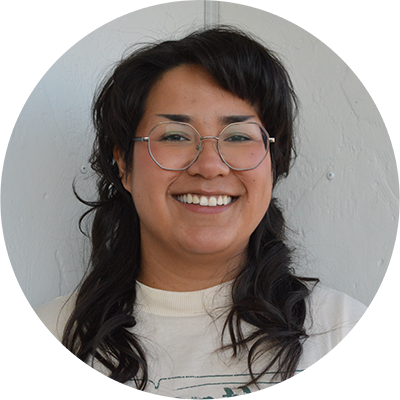
Azby Whitecalf is a Plains Cree Character Designer and Illustrator based out of North Battleford, Saskatchewan Treaty 6 Territory. They have a Bachelor Degree in Visual Communication (Character Design) from the Alberta University of the Arts. Azby’s practice revolves creating fun and exciting stories with memorable and unique characters. An important part of their practice is that they create accurate and positive representation of Indigenous Peoples and cultures and exploring what it is to portray Indigenous People in a way that captures their multi-dimensional identity. Azby enjoys working with bright colours, strong contrast and fun shapes.
Cory Bugden (He/Him)

Cory Bugden is a Canadian illustrator based out of Calgary, Alberta. Originally a graphic designer for an agency that served clients like Oakley, Speedo, and Red Bull; Cory decided to further his artistic capabilities at the Alberta University of the Arts in 2016, completing his degree in 2020. Cory uses bright colours with a fun and whimsical illustration style that can force a smile on anyone's face. When he grows up, Cory wants to be a studio-owner, creative director, children's book illustrator and amateur freestyle rapper.
Daniela Vasco (She/Her)

Daniela Vasco is a 22-year-old Ecuadorian artist, recently graduated from Alberta University of the Arts, with a Bachelor of Design in Illustration. She has been drawing ever since she can remember and is passionate about storytelling, both with words and visuals. She has a love for literature and has published three young adult novels. Daniela’s art is versatile, ranging from children-book illustrations to editorial pieces and animation. She enjoys illustrating portraits that capture a moment, and portraying different emotions throughout her art. Her work always has an underlying feeling of wonder and dreaminess, a reminder to keep a sense of excitement for things we might take for granted.
Kaitlyn Nasogaluak (She/Her)

Kaitlyn Rose Nasogaluak is a 19-year old Indigenous artist from Yellowknife, Northwest Territories. She identifies as part of Sahtu Dene and Inuvialuit descent. Kaitlyn Rose draws mostly human characters, whether they’d be characters from fiction, or her own original ones. Drawing is her passion, it has been for as long as she can remember. She loves listening to music, driving, and playing video games.
Leah Prisque (She/Her)
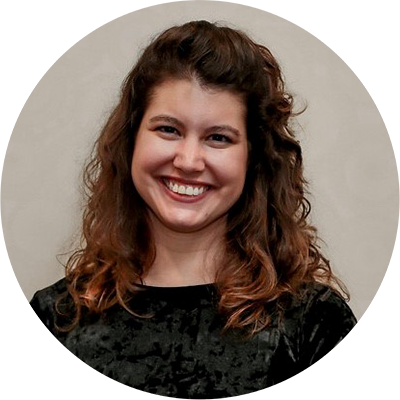
Leah Prisque's spiritual name is Waabano Pichi Kwe, meaning “Light of Dawn Robin Woman,” which was gifted to her in 2018. She is an Ojibwe Métis woman from Port Severn, Ontario, a very small town on the cusp of Muskoka. She enjoys creating multimedia art, cooking, camping, spending time on the water, and with her partner and her pack of pets!
Morgaine Johnson (She/Her)
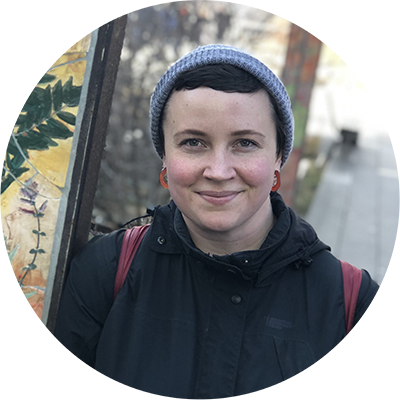
Morgaine Johnson was born and raised in Treaty 7 territory, Mohkinstsis, Calgary, Alberta. She recently graduated from the Alberta University of the Arts in Calgary with a Bachelor of Design in Illustration, and has a professional background in cooking and baking. She finds inspiration from the natural world, vintage patterns and typography, movies and films. Morgaine has recently taken up collecting plants, bookbinding and quilting. She loves doing a lot of different things!
©Her Majesty the Queen in Right of Canada, 2021
Catalogue number: CH4-193/2021E-PDF
ISBN: 978-0-660-39317-9